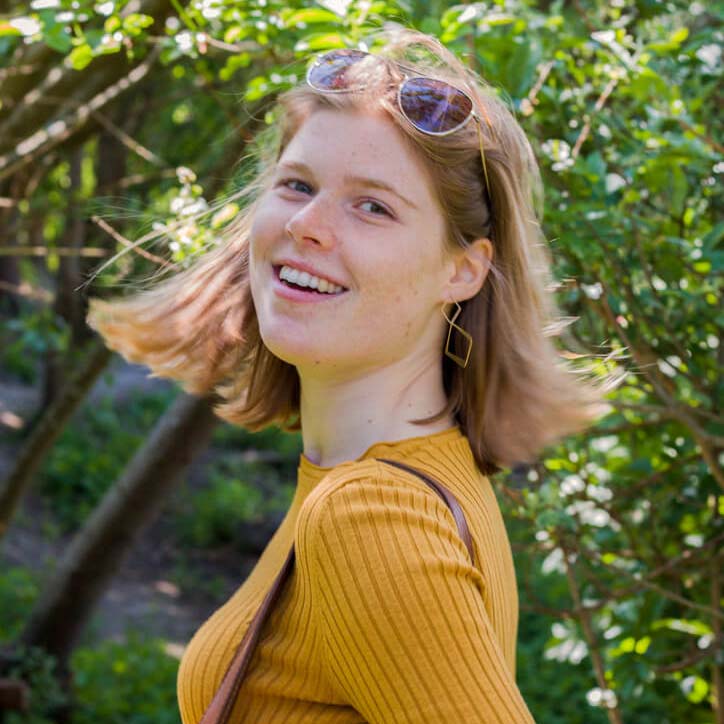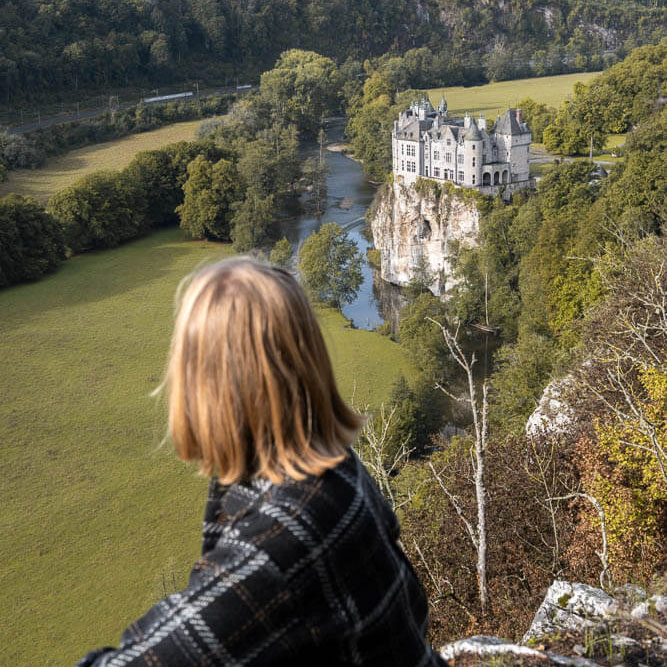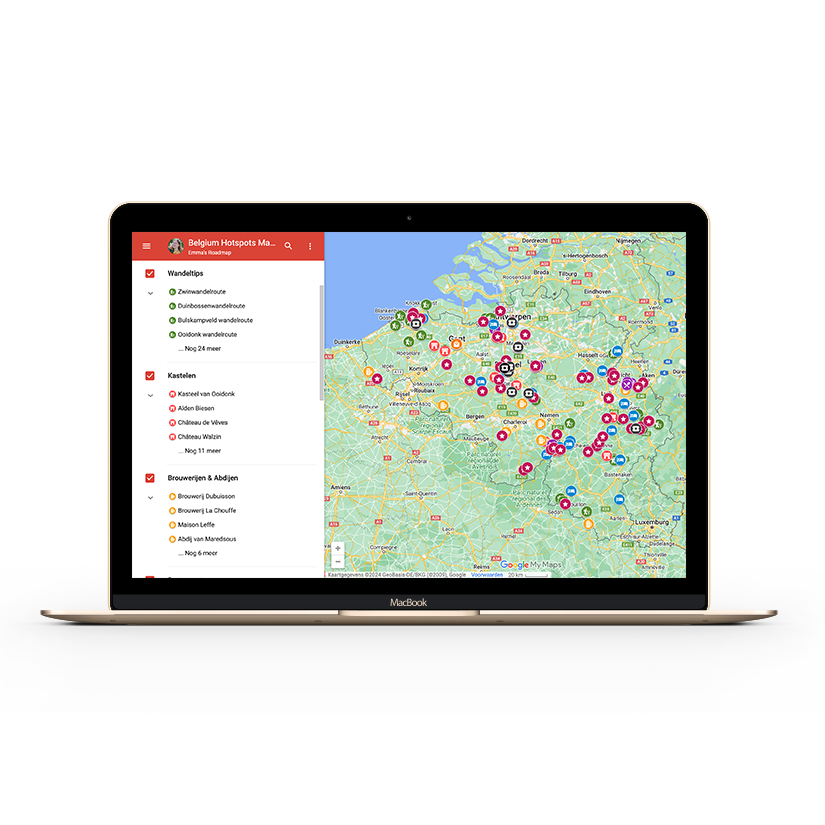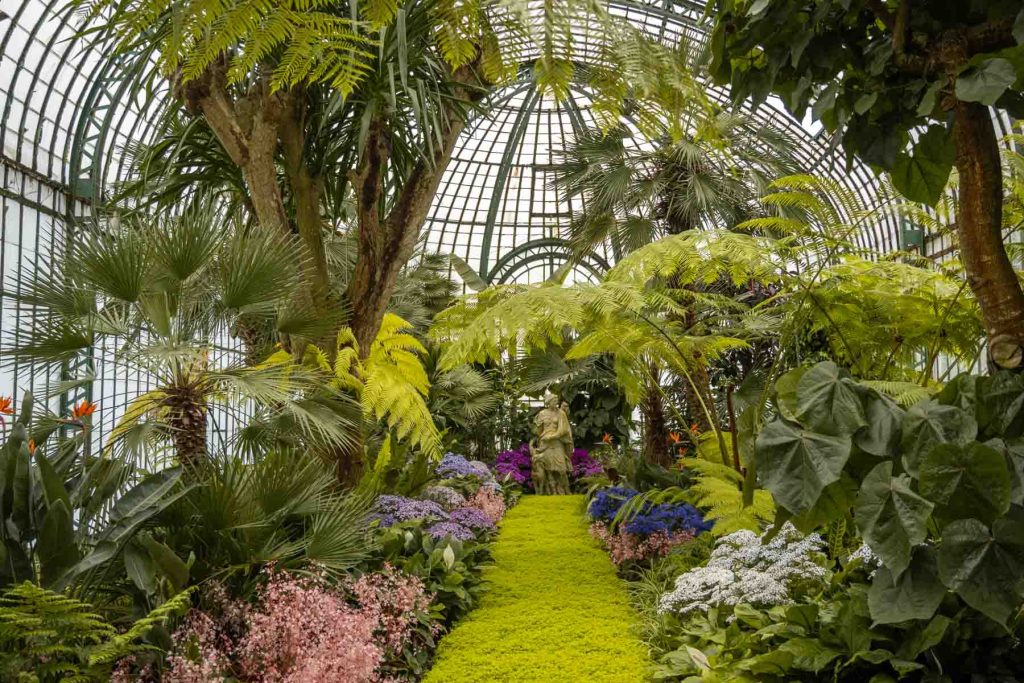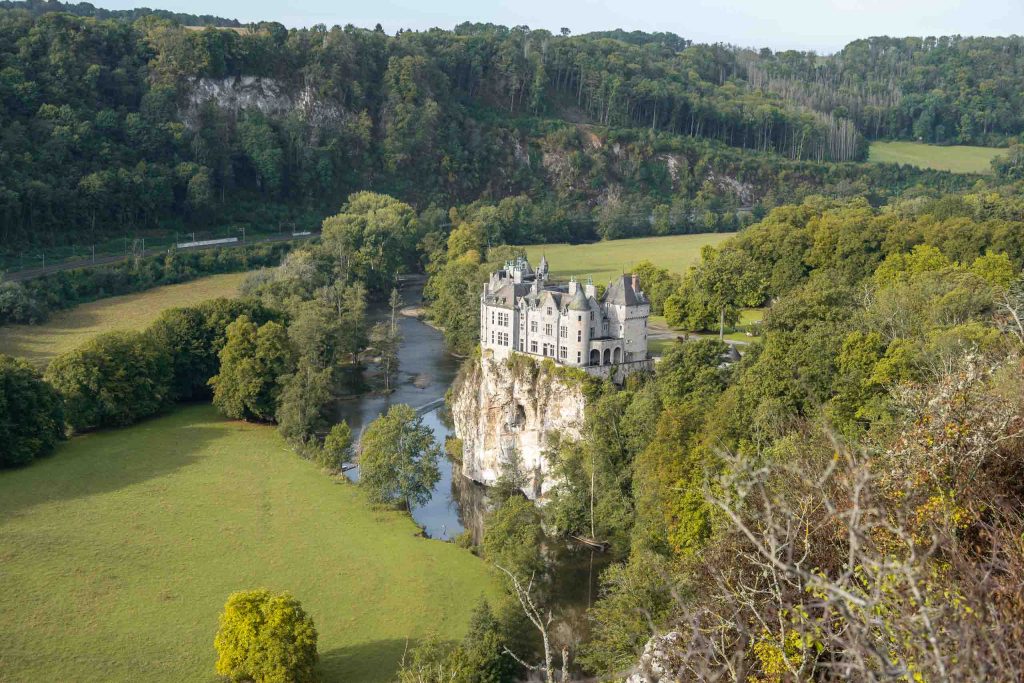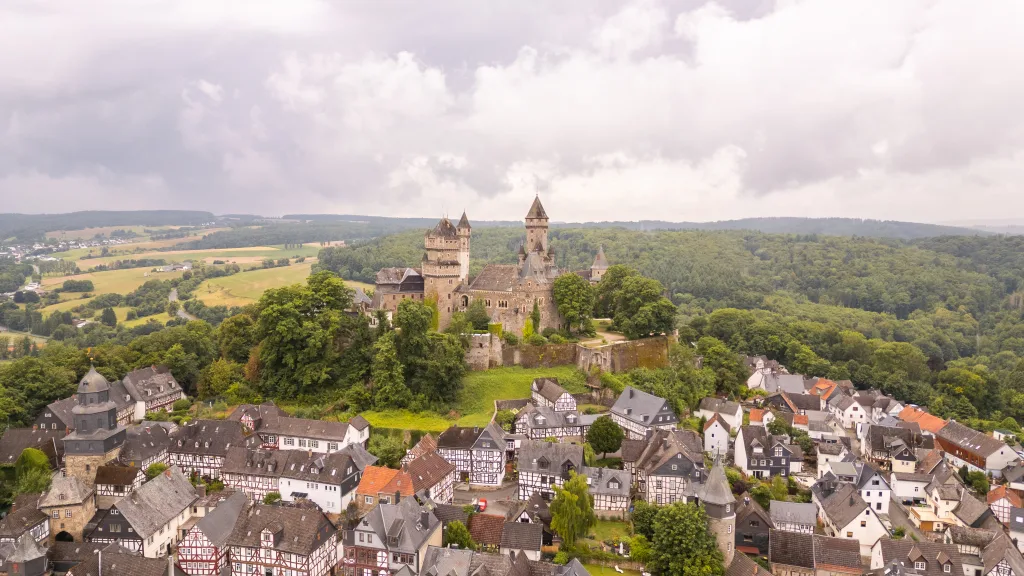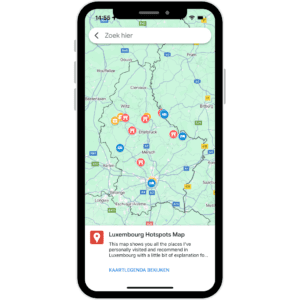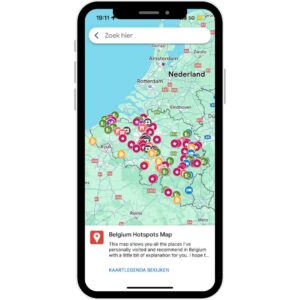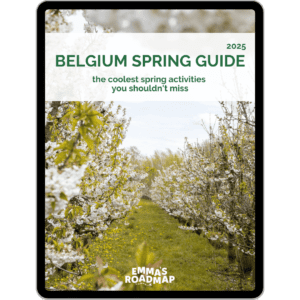A motorbike tour in Germany? Then Hesse is the place to be! This region – between the Main and Lahn rivers – is ideal for those who love the oh-so-typical German towns and villages with half-timbered houses. In five days, you drive from half-timbered pearl to half-timbered pearl, with forests, castles and rivers along the way. And it couldn’t be more convenient, just follow the Deutsche Fachwerkstraße.
The Deutsche Fachwerkstraße is an official cultural route linking more than 100 half-timbered towns in Germany. Think colourful facades, cobbled squares and a historic altstadt. For motorcyclists, special routes have even been mapped out – in cooperation with Motorradstraßen Deutschland – combining the most beautiful towns with quiet, winding roads. Perfect for a first motorbike tour… and it was for me, too.
Because honestly? This trip was my very first motorbike tour ever. My boyfriend rode, I sat on the back. He had never taken anyone on the back before, and I had never taken a road trip that way. Exciting, then! But after a few nervous turns and a lot of bumping between helmets along the way, everything went surprisingly smoothly.
In this blog post, I take you day by day on our 5-day motorcycle tour through Hesse, around Frankfurt. Including personal tips, fun stops, fine dining addresses and everything you need to know if you feel like jumping on the motorcycle towards Germany yourself!
💡 Want to know more about the Deutsche Fachwerkstraße? Check out the website here!
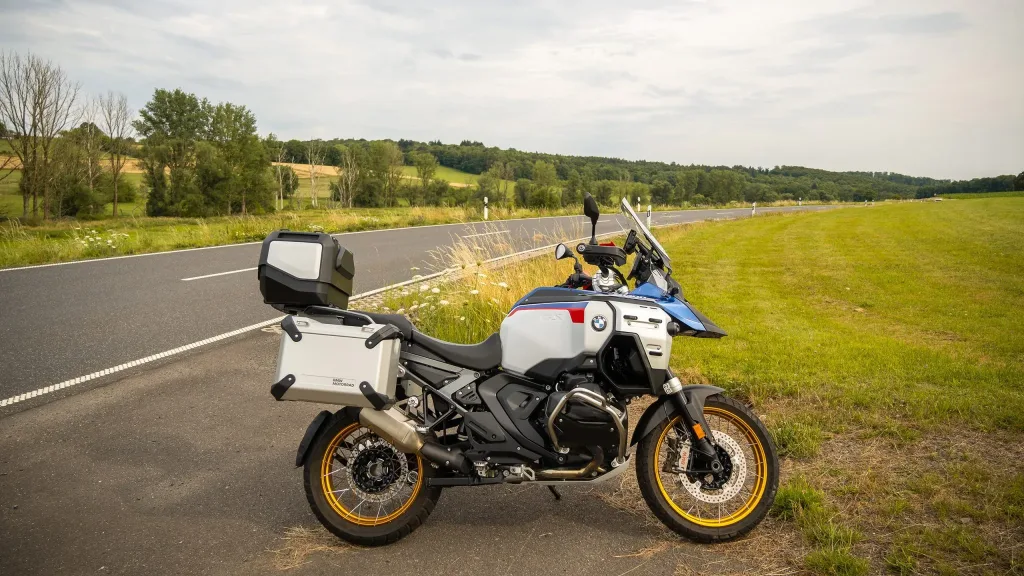
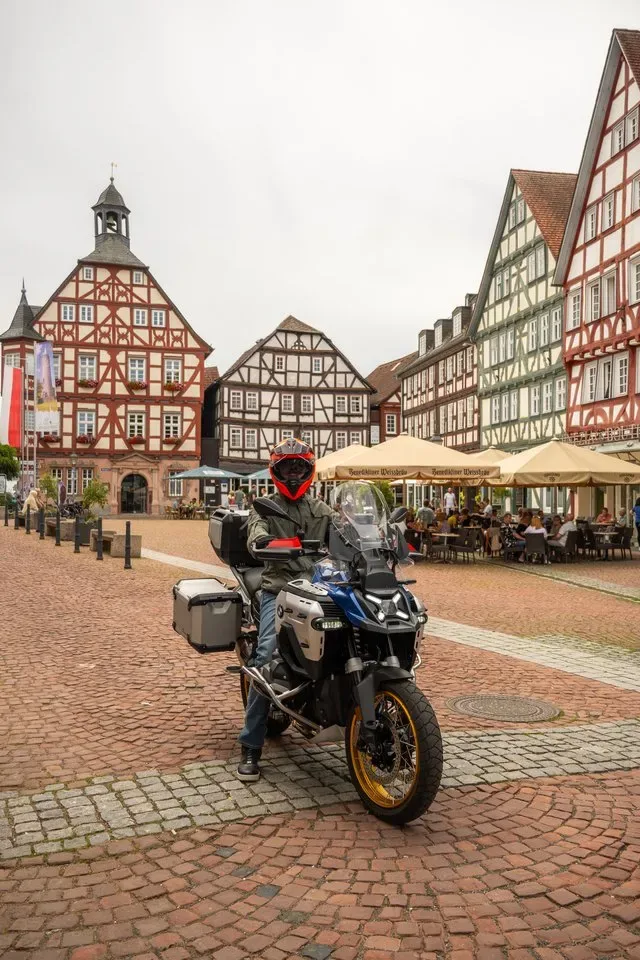
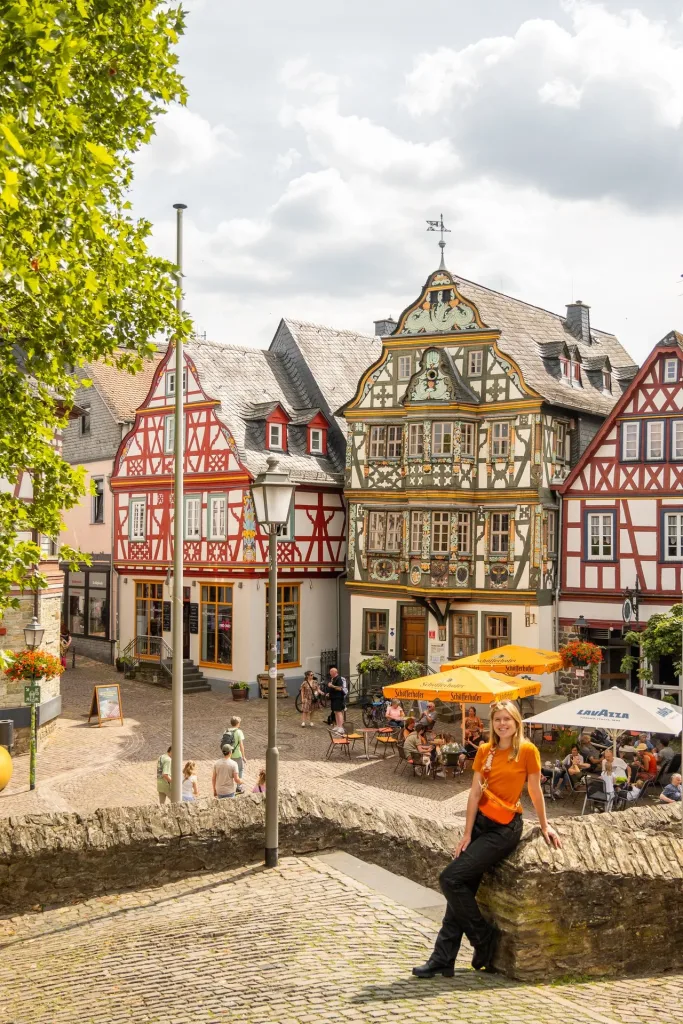
Day 1: arrival in Limburg an der Lahn & test ride to Montabaur
Our motorbike journey did not start right away on two wheels. We left from Bruges by car and a remorque with the bike on top. Why? Because we did not immediately feel like a long, straight ride on the motorway with just the two of us on the motorcycle – especially not for a first time together. So we opted for the comfortable option: ride into Germany and only then really start there. Limburg an der Lahn became our base.
Tip: We parked our car and remorque on the outskirts of Limburg, in the Markthalle car park, about a 12-minute walk from the centre. You can park there unlimitedly for free and the car park was very spacious so that was ideal!
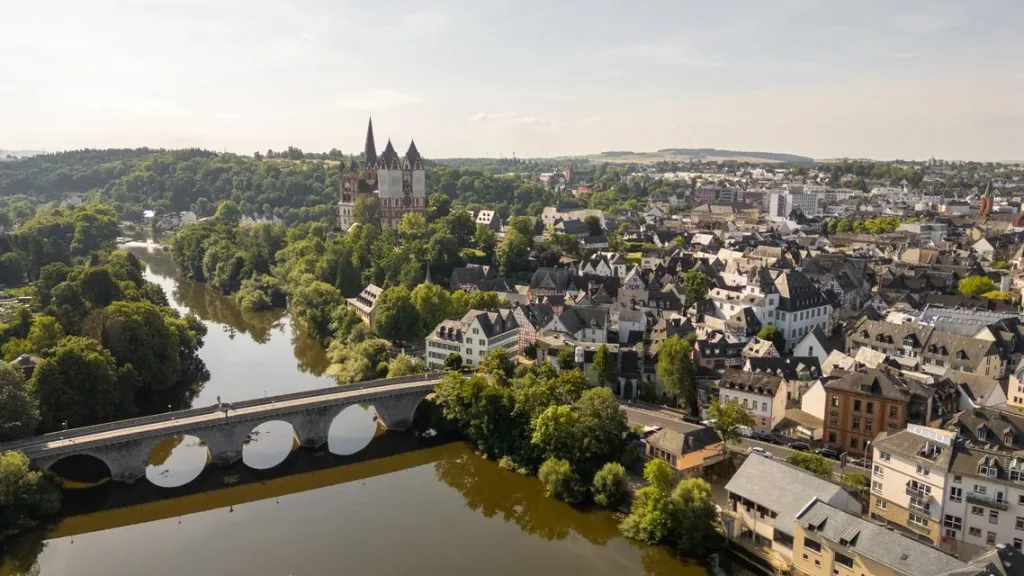
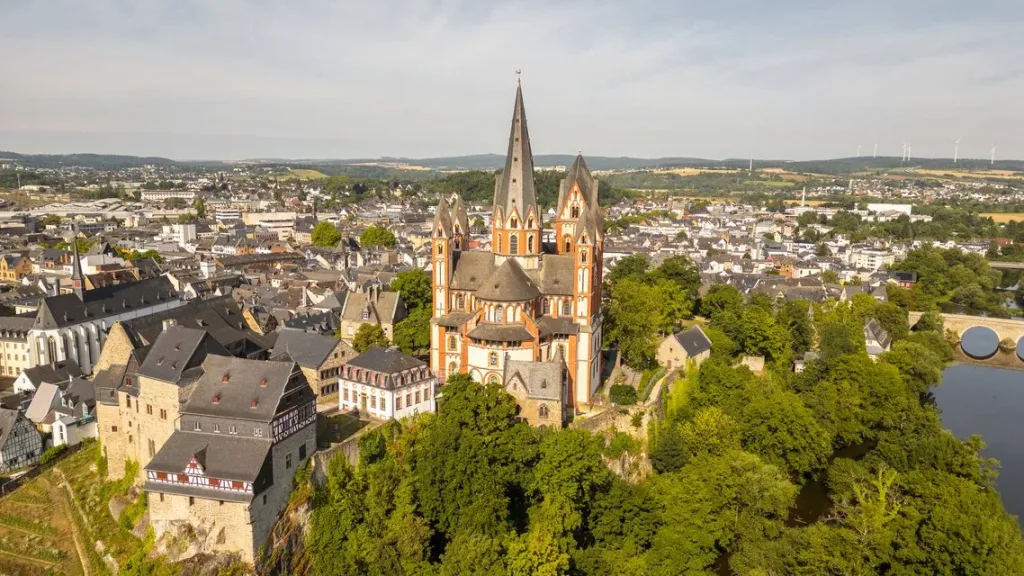
Checking in at Hotel Nassauer Hof
We arrived a little after noon and parked our car with trailer just outside the city centre. Then we checked into Hotel Nassauer Hof, a typical German hotel overlooking the old bridge and the river. You’re right on the edge of the Altstadt, ideal for exploring everything on foot. The rooms are simple but clean, with a small balcony and a view of the water. Breakfast the next morning was extensive enough – with sufficient options to start the day off right.
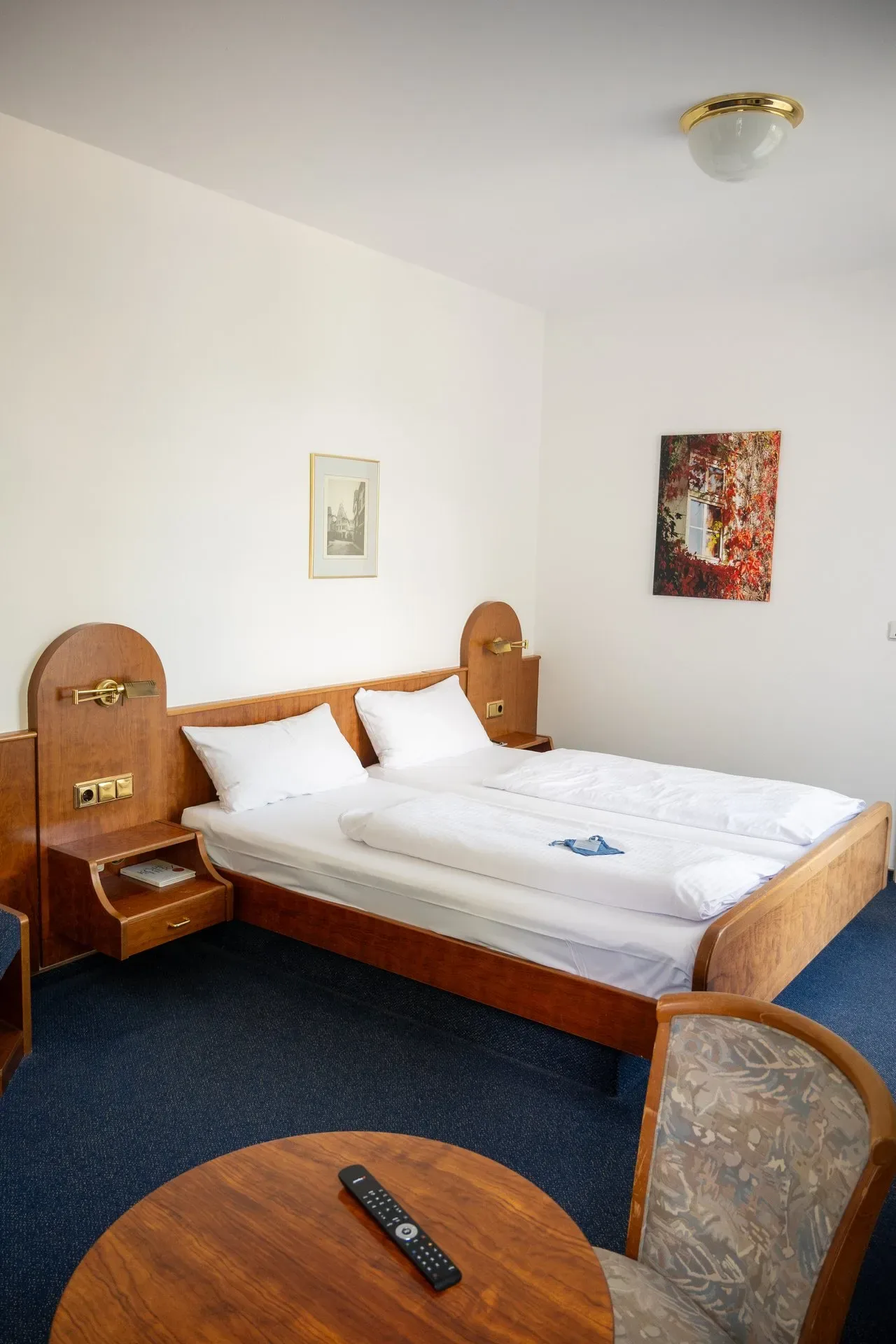
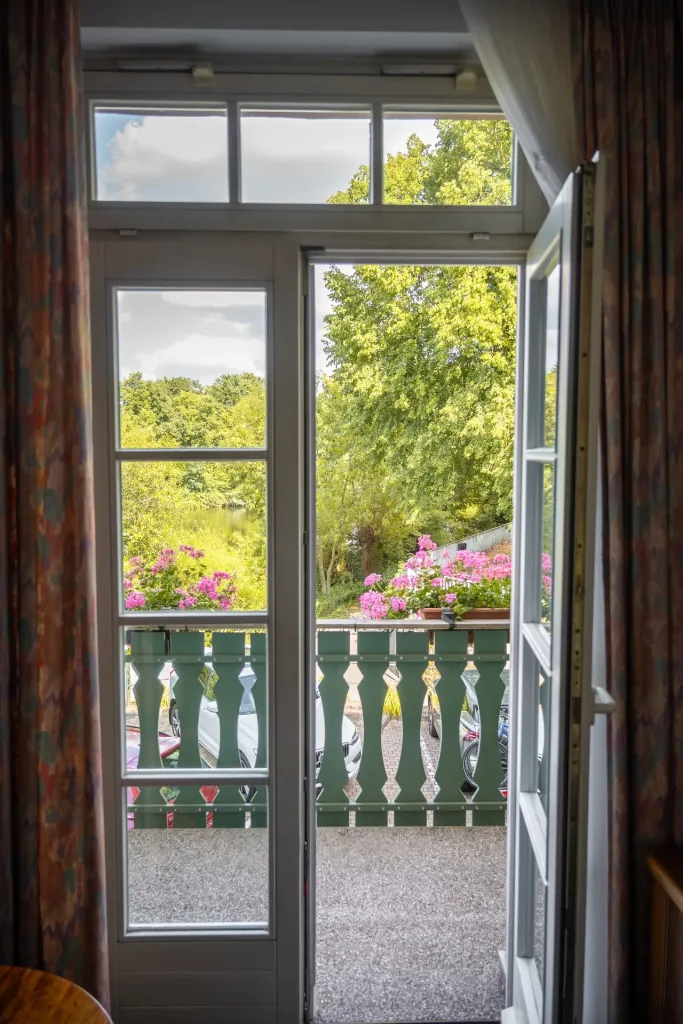
Test ride to Montabaur
After checking in, we did what many motorcyclists recommend at the start of a new trip: a short test ride to get used to each other and the bike. We rode for just under half an hour towards Montabaur, a cute half-timbered village on a hill. On the way, we enjoyed winding roads and a first introduction to the landscape of the Lahn region.
Montabaur itself is not big – a few streets in the centre – but certainly charming. On the market square, locals were enjoying themselves on terraces, live music was playing and there was a fantastic holiday atmosphere. We took a short walk past the half-timbered houses, visited the church on the hill (with nice views over the valley), and then returned towards Limburg at ease.
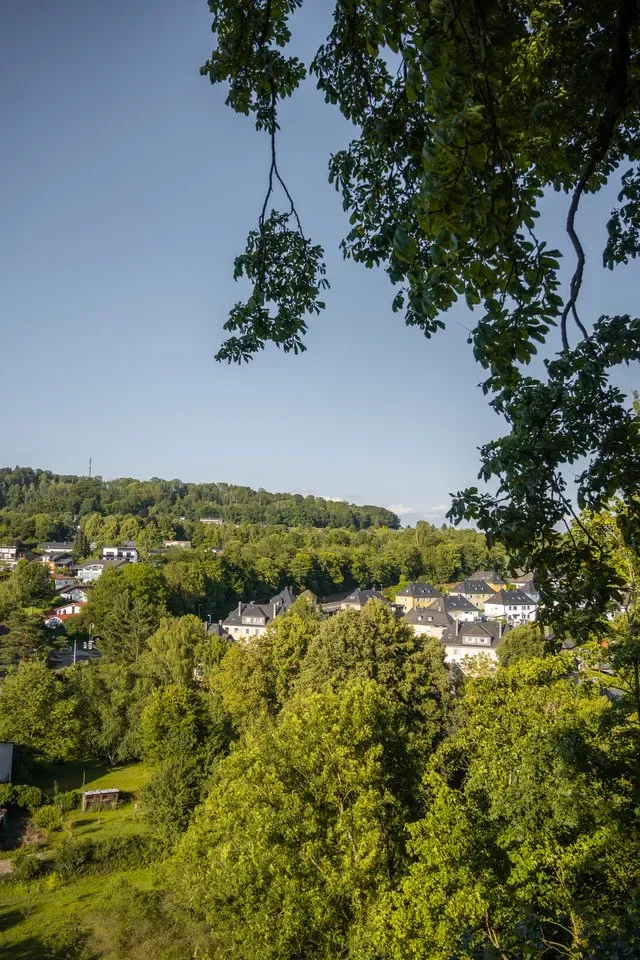
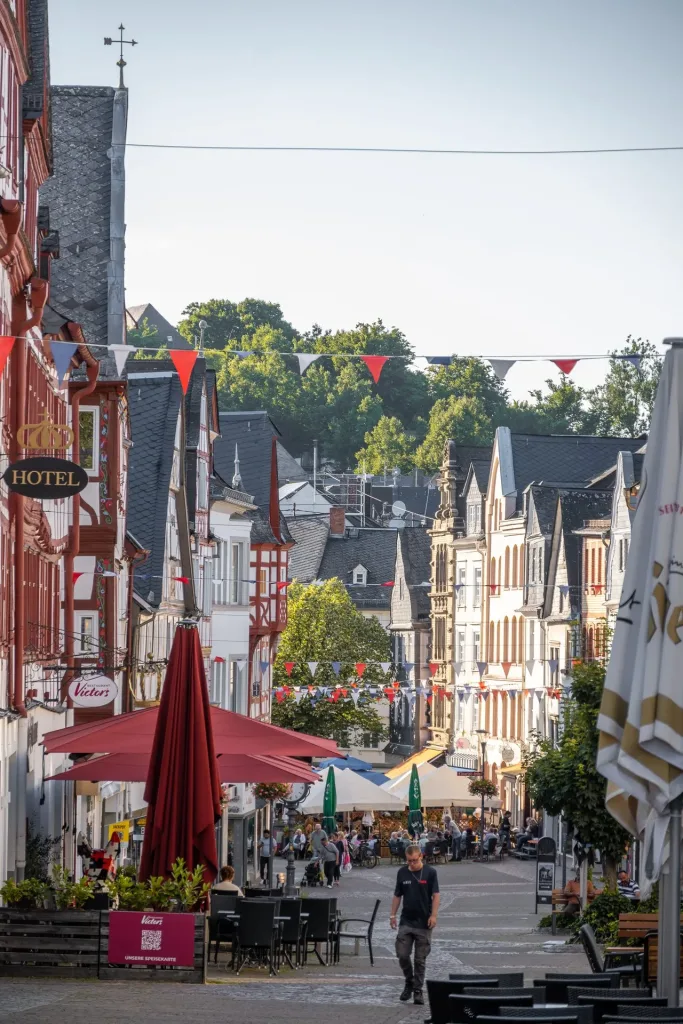
Local dinner at Gasthaus Burgkeller
In the evening, we had dinner at Gasthaus Burgkeller, where I ate a delicious schnitzel with Grüne Soße – a local speciality you should definitely try. The little restaurant is right in the middle of the Altstadt, so a prime location!
We then ended the day with a leisurely evening stroll through the old town. Limburg an der Lahn is not a big city, but it is a photogenic place with half-timbered houses in all shapes and colours, cosy squares and, of course, the imposing cathedral.
Tip: Around sunset, by the way, that cathedral takes on a beautiful glow. Be sure to walk up to the cemetery next to the cathedral: you’ll get a panoramic view of the river and the surrounding valley – a great place to end your first day of motorcycling.
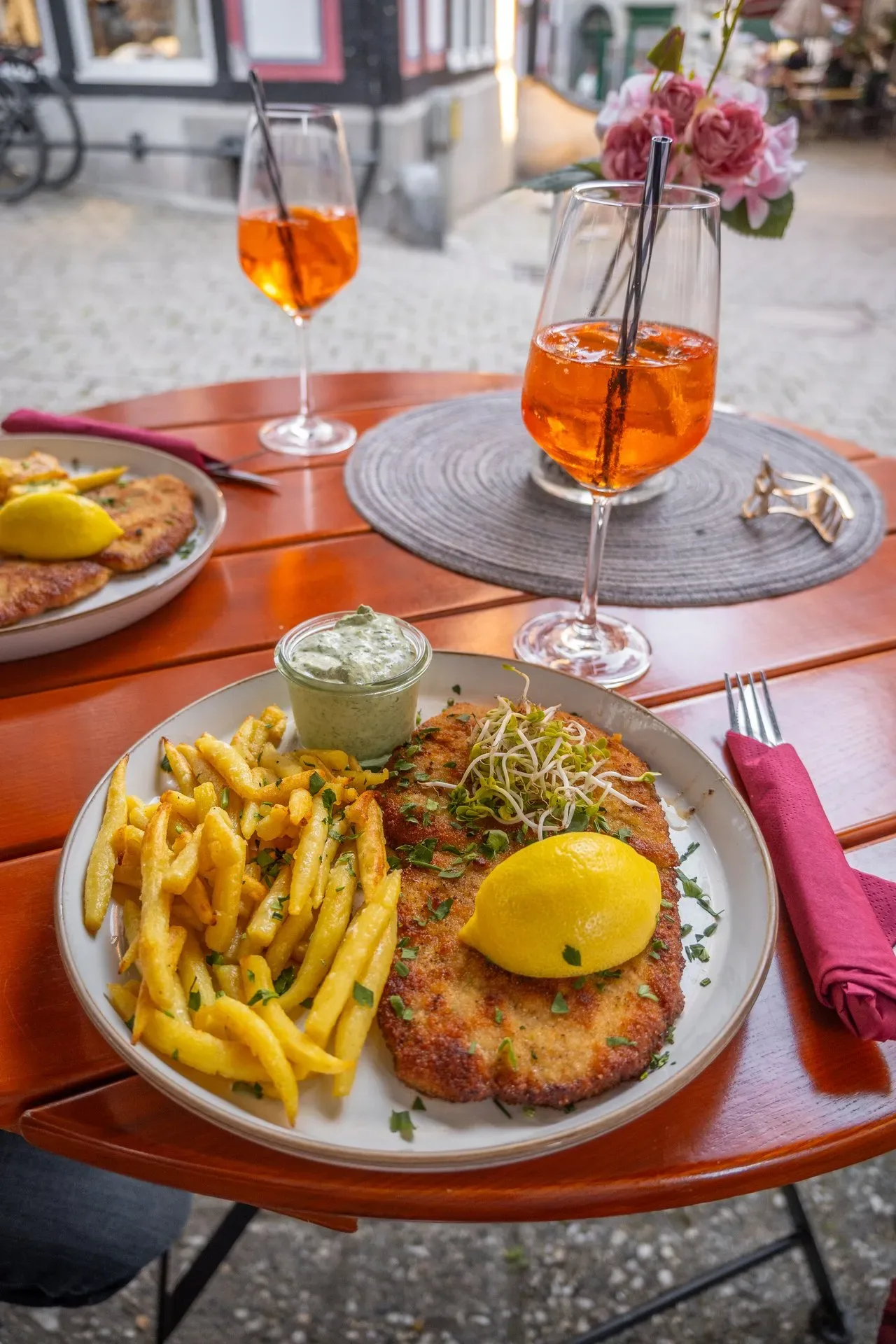
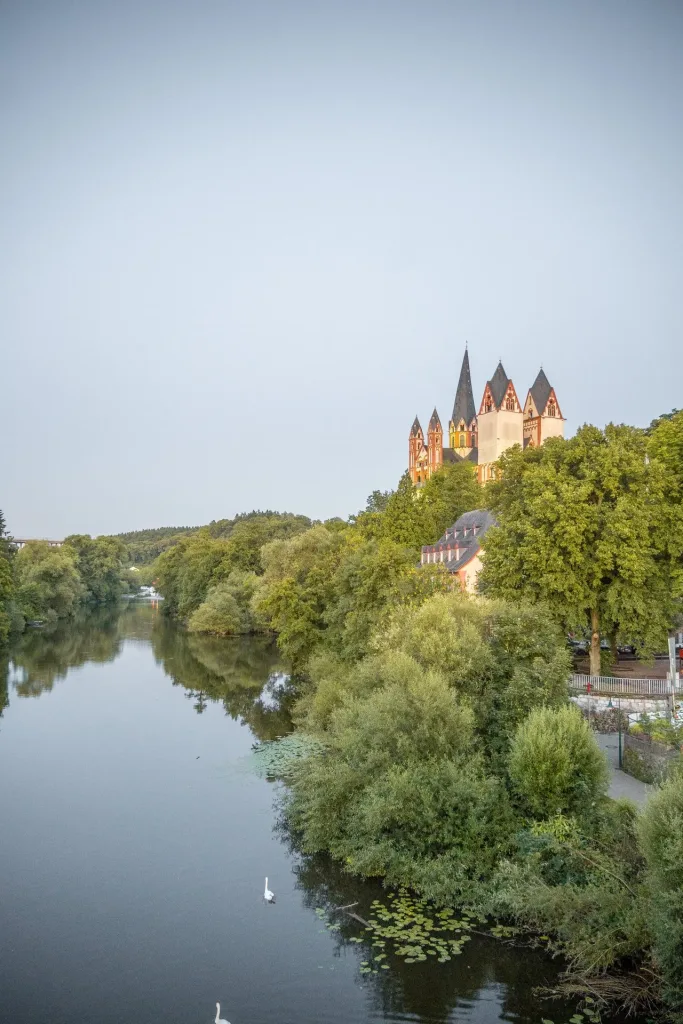
Day 2: from Limburg to Seligenstadt: a day full of stops
After an initial reconnaissance the previous day, we really started our motorcycle tour through Germany on day 2. We left the car at the car park in Limburg an der Lahn and from now on we would only travel by motorcycle for four days. Exciting!
Although it was a bit of a puzzle at first: everything had to go in the side and rear panniers of the motorbike – and that turned out to be a bit more cramped than we had expected. Especially with a camera and drone. But anyway, everything got in and we were ready to go.
Tip: download the GPX route of our day here.
Visiting Limburg an der Lahn
Before we left Limburg for good, we took a short walk through the town. And that is highly recommended, because Limburg an der Lahn is one of the most charming half-timbered towns in Germany. You can perfectly wander around for a few hours.
The town originated in the early Middle Ages on an important trade route between Cologne and Frankfurt, which you can still feel in the compact but lively centre. The impressive Limburg Dom in particular – built around 1235 – bears witness to the city’s rich history. Limburg was largely spared during the wars and still exudes that authentic atmosphere today. Some places not to miss:
- Limburg Dom – an impressive cathedral located on a rock above the city. Especially around sunset, the view here is magical.
- The Alte Lahnbrücke – the old bridge over the river is a great photo point, with views of the cathedral and the colourful waterfront houses.
- The historic Altstadt – a maze of cobbled streets, half-timbered houses of all colours, cosy squares and a surprising number of small boutiques and cafés.
- The Diözesanmuseum – for those who want to take in some culture: this museum is located near the cathedral and offers not only religious art, but also a nice view of the city from the courtyard.
- Römer 2-4-6-8 – one of the oldest half-timbered houses in Germany.
👉 For more tips and photos, read my separate blog post about Limburg an der Lahn.
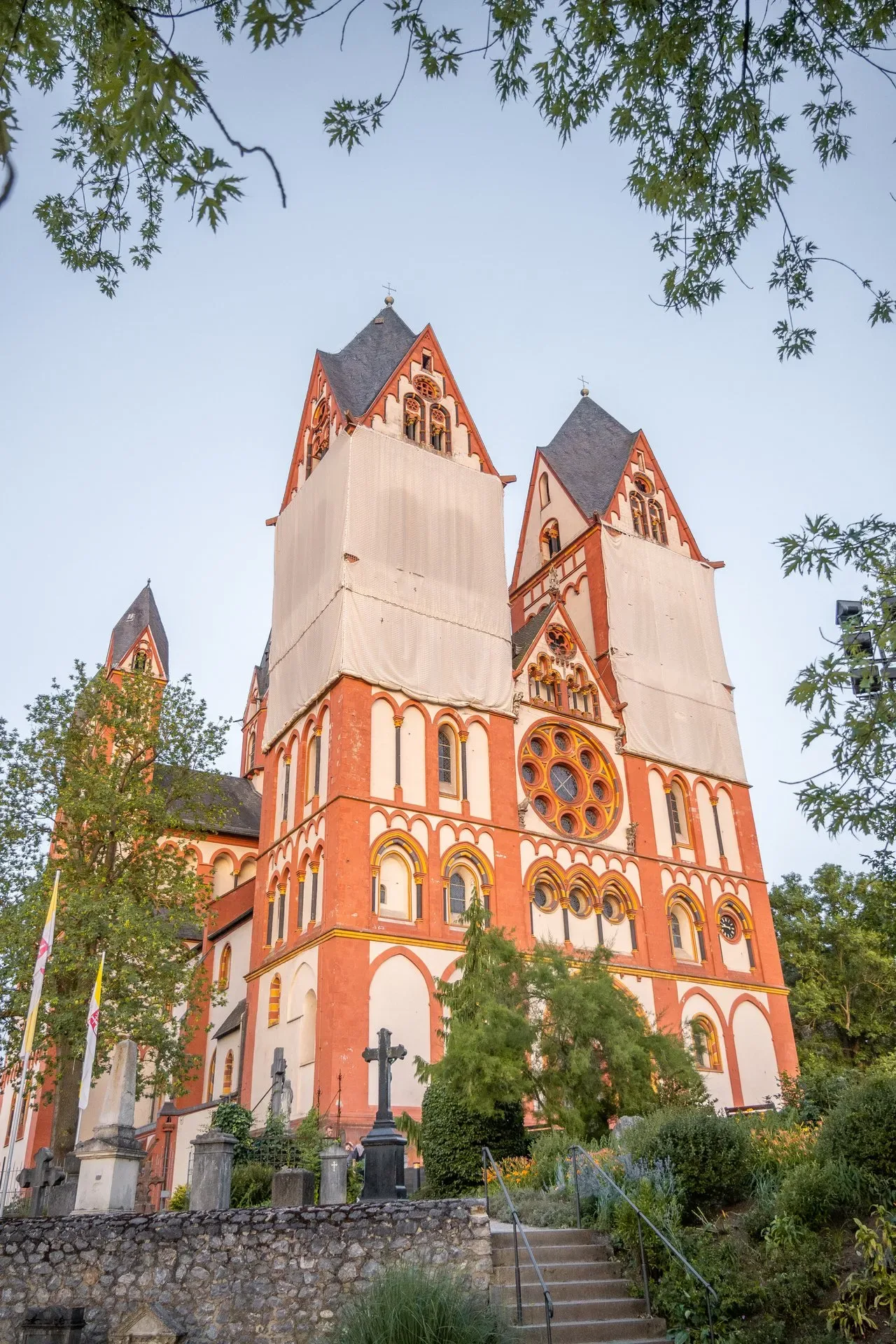
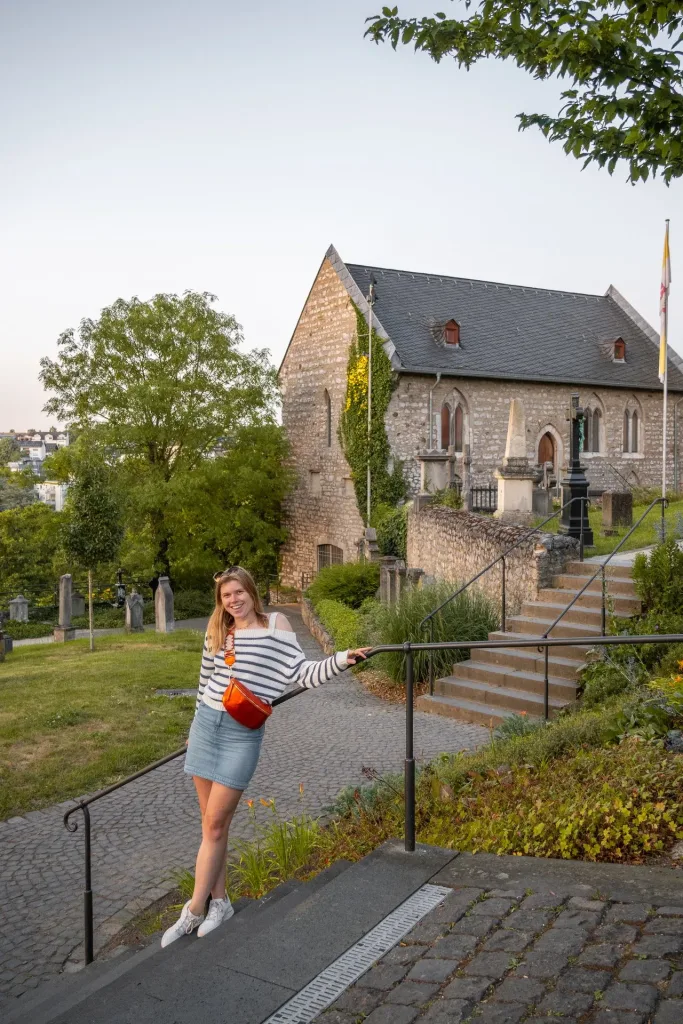
Around noon, we left for our next stop: Seligenstadt, a charming town along the Main river. The route there would take about three hours by motorbike, but on the way we wanted to explore several villages. On the list: Bad Camberg, Idstein, Frankfurt-Höchst and Dreieich. We ended up skipping the latter due to lack of time – if you want to look around everywhere, the hours add up quickly. But the stops we did make were well worth it.
Stop 1: Bad Camberg
Bad Camberg is small but cosy. The centre consists of one charming market square with half-timbered houses, a church you can stroll into, and a handful of pavement cafés. We had lunch there on the square at lunch bar Café Kuss with surprisingly tasty tapas. The ideal lunch break!
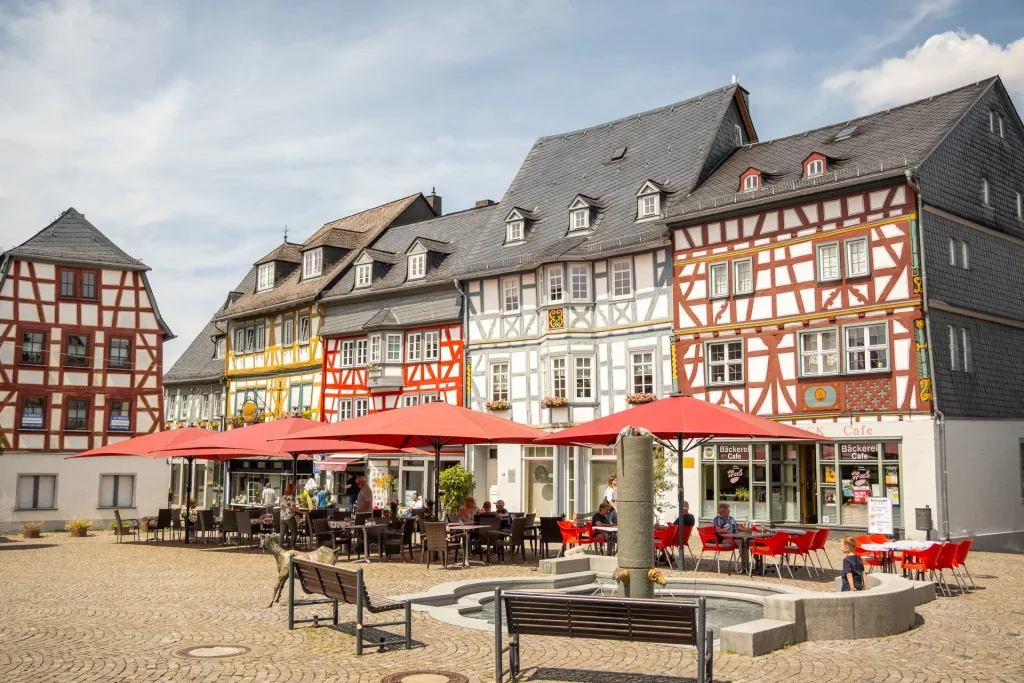
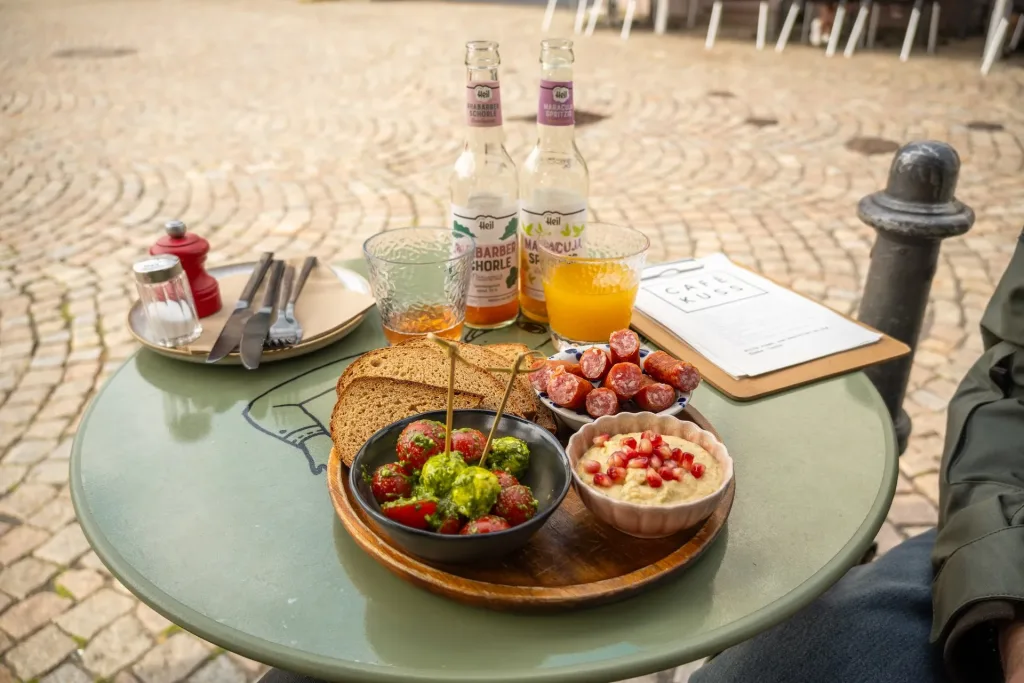
Stop 2: Idstein
The discovery of the day. Idstein was without doubt the most beautiful stop on our route that day. The Altstadt is small but insanely picturesque, with an attractive market square, beautiful half-timbered facades, an old city gate, a castle, gardens and even a Witches’ Tower. We could easily have stayed here a bit longer.
Tip: Do you only have time for 1 single stopover? Then choose Idstein without hesitation!
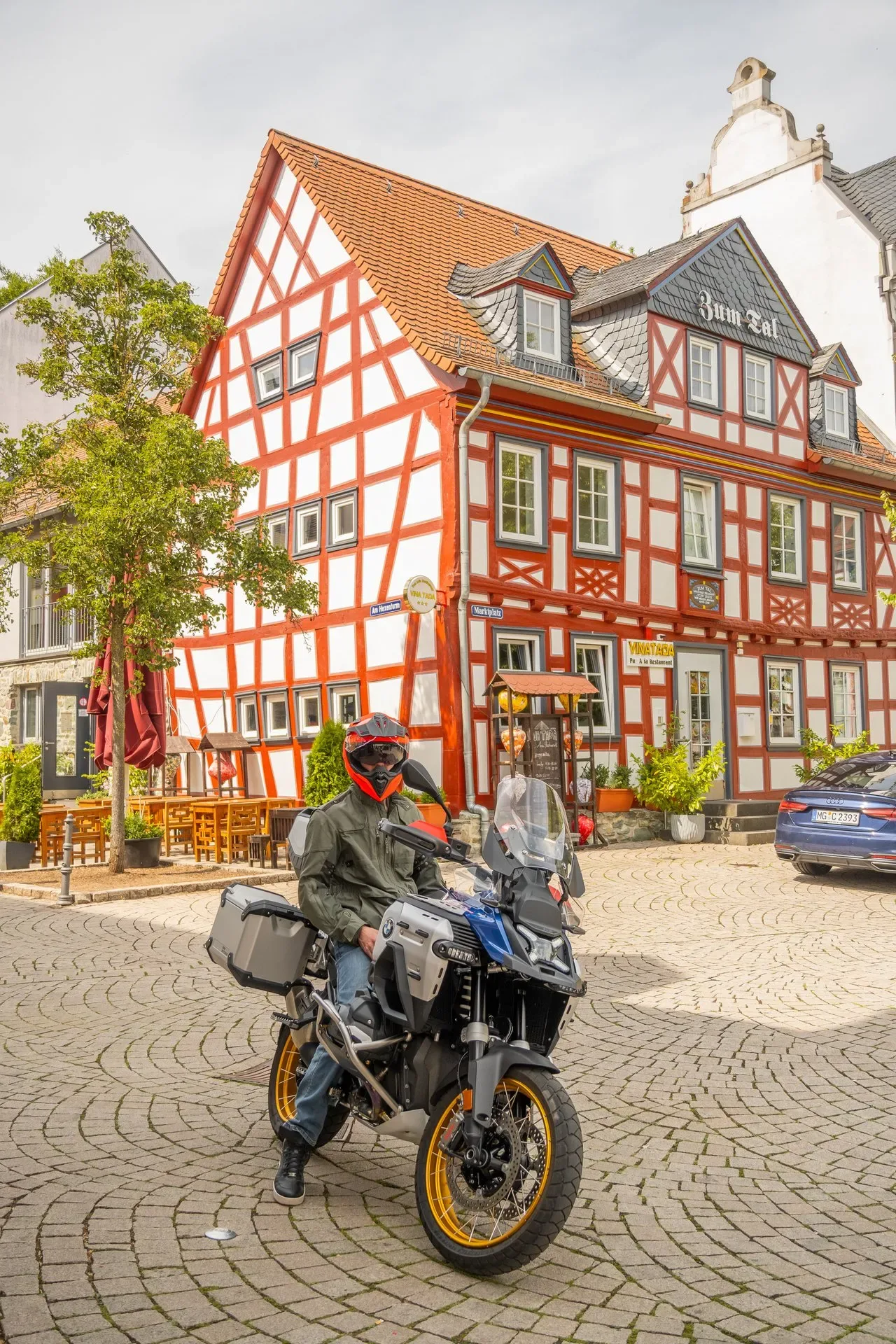
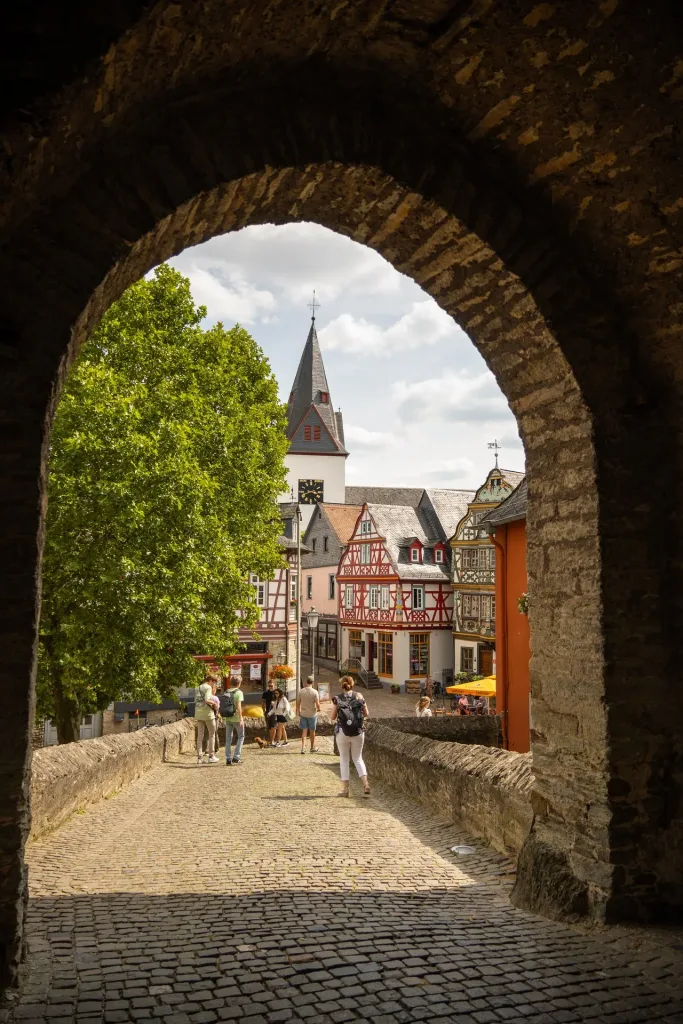
Stop 3: Frankfurt-Höchst
We then drove on to Frankfurt-Höchst, a borough of Frankfurt with a surprisingly charming old centre. The highlight is the castle with thick city walls, which you can walk on top of. When we were there they were renovating in full swing, so hopefully it will look even better soon. On the banks of the Main is a cosy summer bar – perfect to have a drink and cool off with a view of the water and the city walls.
Tip: On day 1, I was still naive enough to keep my motorbike clothes on during our stops in towns along the way. A big mistake, because at 29 degrees I felt like a boiled lobster by the end of the day. So for the next few days, I strategically put on shorts under my motorbike shorts and threw off all warm clothing each time I stopped.
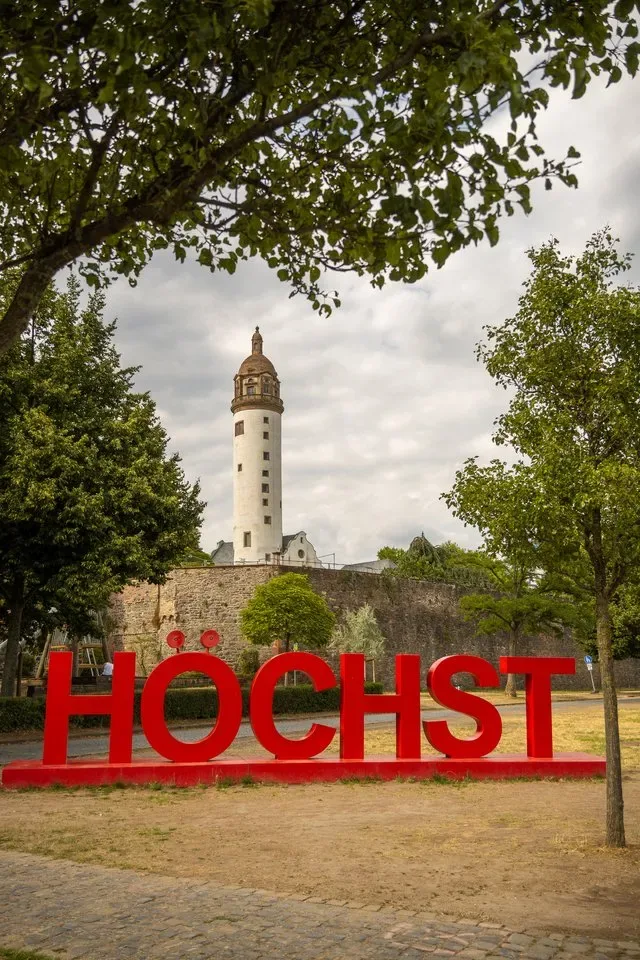
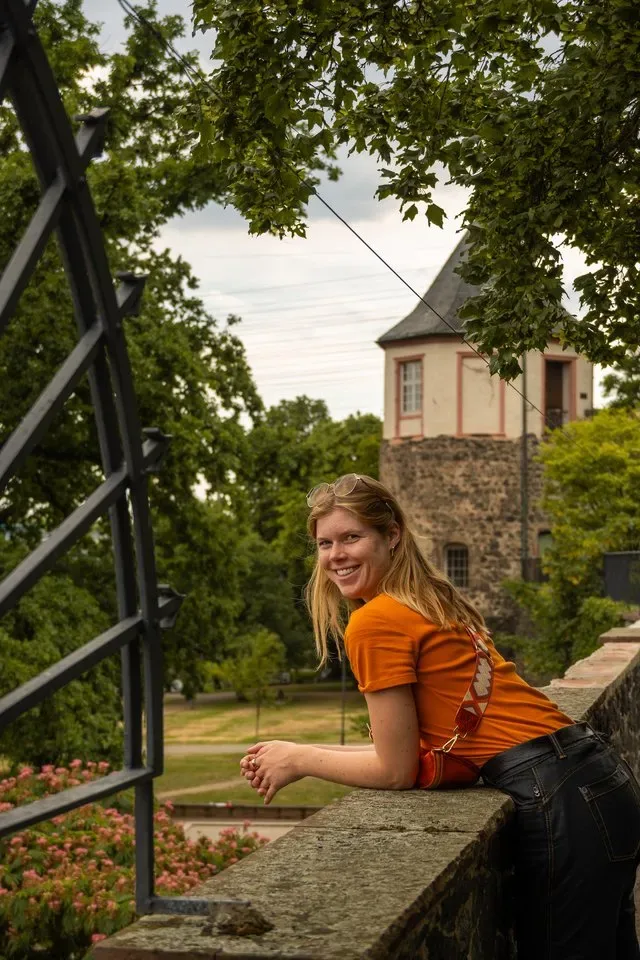
We ultimately left Dreieich behind, and by evening we arrived in Seligenstadt.
Seligenstadt is an ambient town on the banks of the Main, about 30 km from Frankfurt. The town has a rich history dating back to Roman times, but above all it grew into a religious and cultural centre thanks to the abbey founded in the 9th century by Einhard, Charlemagne’s biographer.
Today in Seligenstadt you will find a beautifully preserved old centre with colourful half-timbered houses, cobbled streets and cosy squares. The abbey with its baroque cloister garden forms the heart of the town and, together with the river and the many terraces, makes for a wonderful holiday feeling.
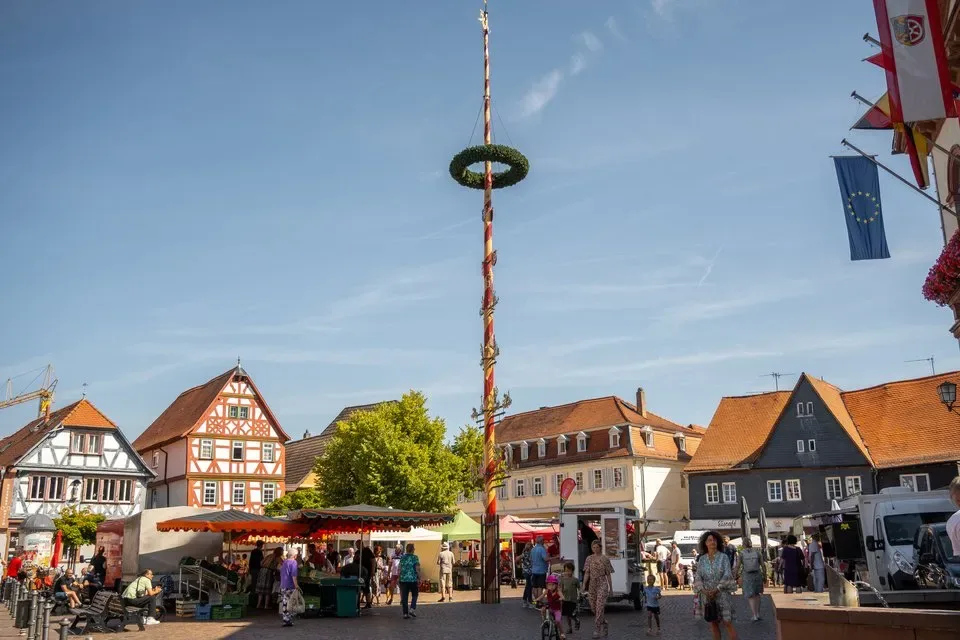
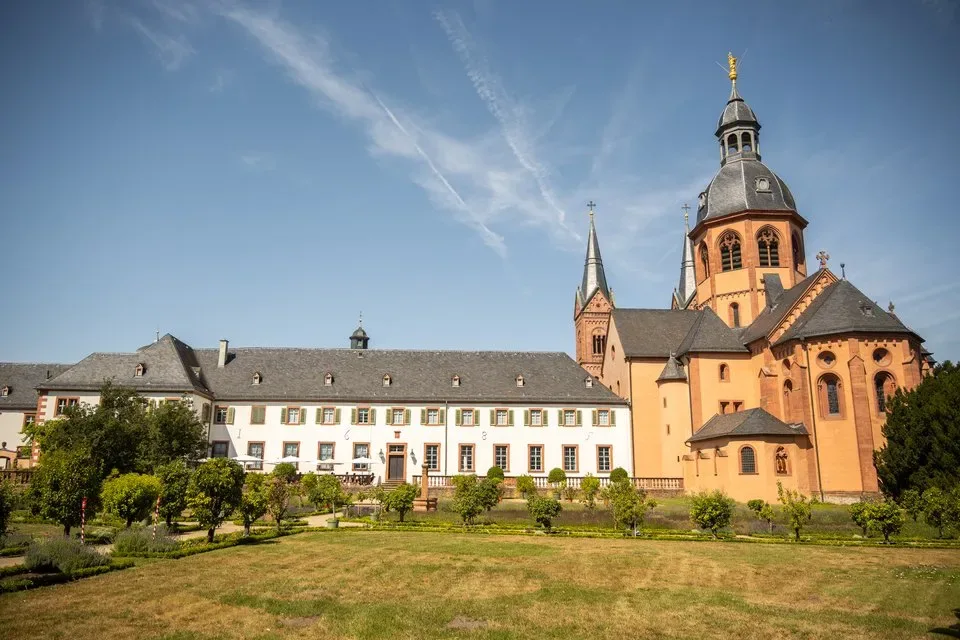
Overnight: Landgasthof Neubauer (GenussReich)
Our sleeping place in Seligenstadt, Landgasthof Neubauer, was located just outside the city centre, in a modern extension of an older guesthouse. The room was clean and spacious, but lacked a bit of charm. It was fine for one night, but if you have the choice, I recommend staying in the old centre of Seligenstadt. You’ll be right among the atmosphere, within walking distance of everything. We had to walk a good 25 minutes to the city centre.
The breakfast was a real winner: you order what you want in advance and the next morning everything is freshly prepared for you – top service!
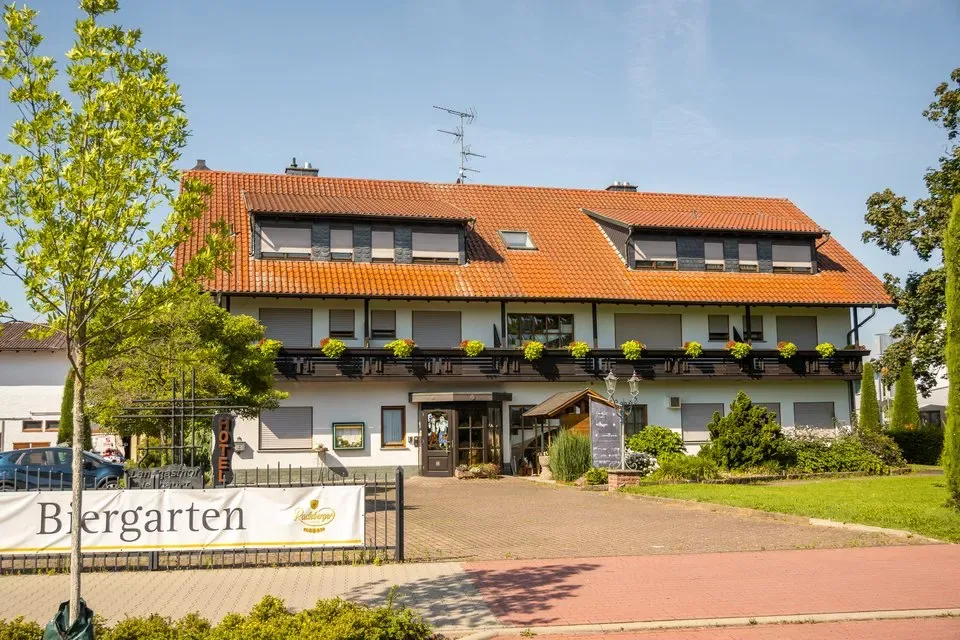
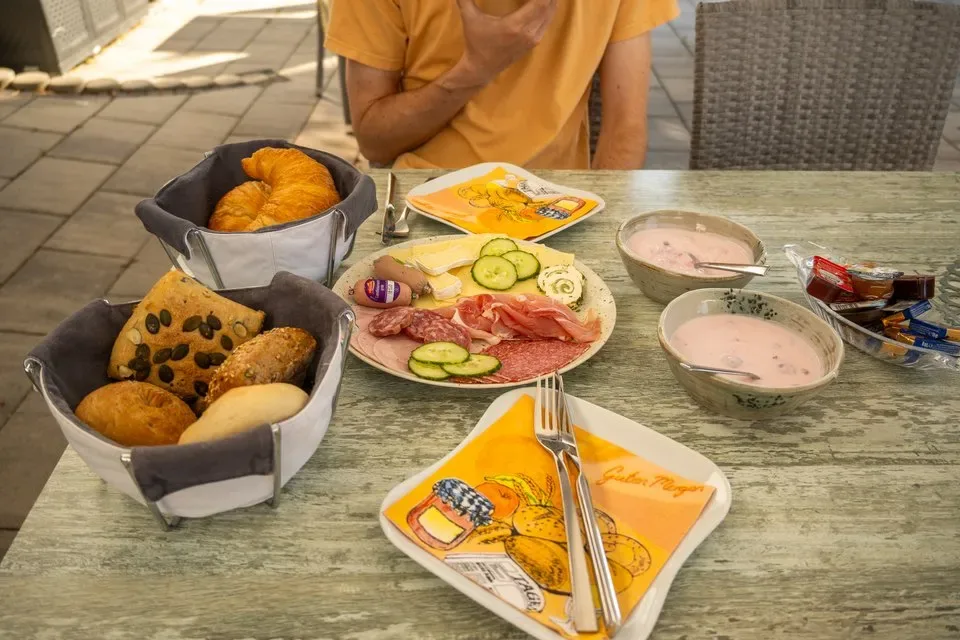
Dinner at Hollis Trattoria – highly recommended!
In the evening, we had dinner at Hollis Trattoria, an Italian restaurant that had just opened. And I am not exaggerating when I say that this was possibly the best pizza I have ever eaten (outside Italy, that is). You sit there in a small square right next to the old abbey, overlooking the church. All around were terraces where locals were also enjoying the summer evening, atmosphere at its best!
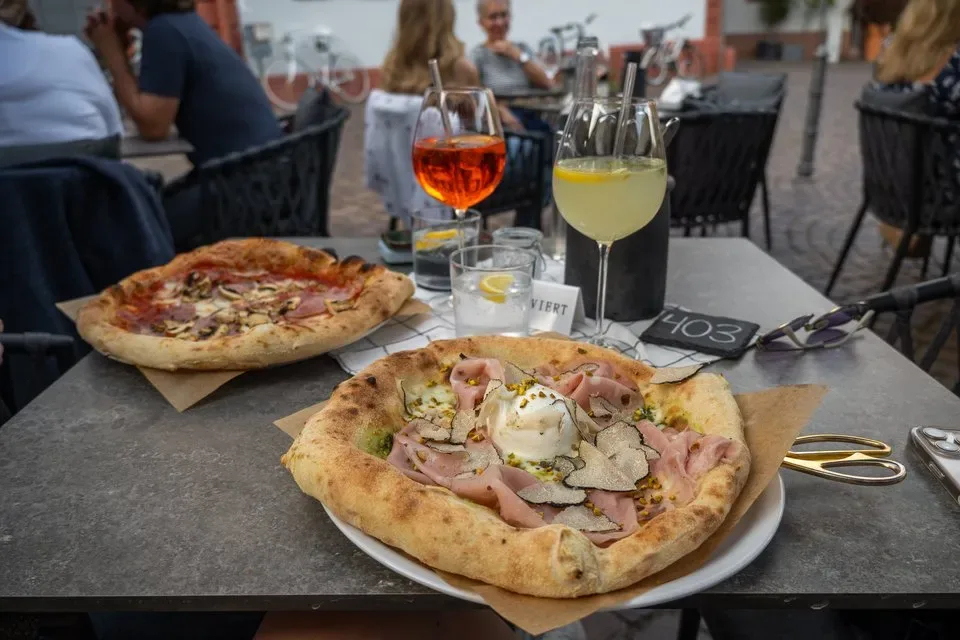
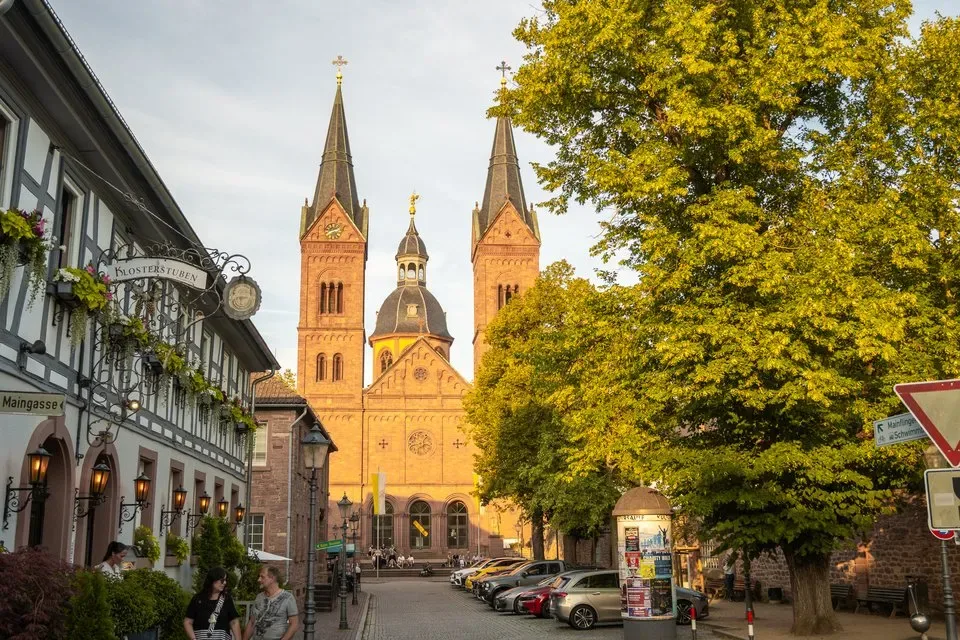
Day 3: from Seligenstadt to Grünberg
After two days of getting used to it, on day 3 we had finally got the hang of it. Riding was smoother, we now knew the best way to pack everything, and above all: the twisty trail and beautiful weather made this the most enjoyable bike ride so far.
But before leaving Seligenstadt behind, we headed into the city centre for a guided walk around the town. Because although we had enjoyed the atmosphere the night before, we hadn’t really taken the time to explore Seligenstadt yet – and that would be a shame.
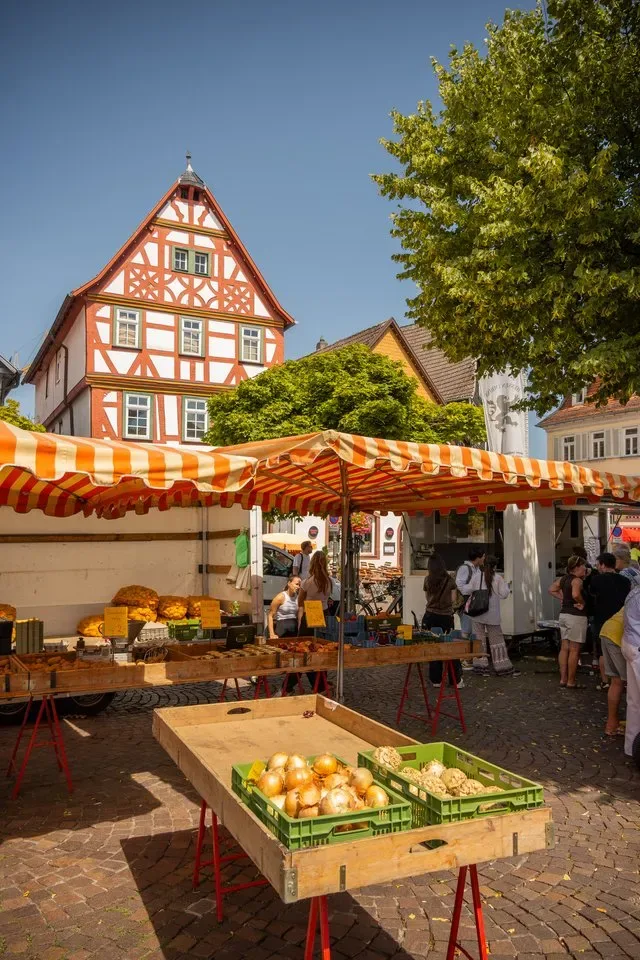
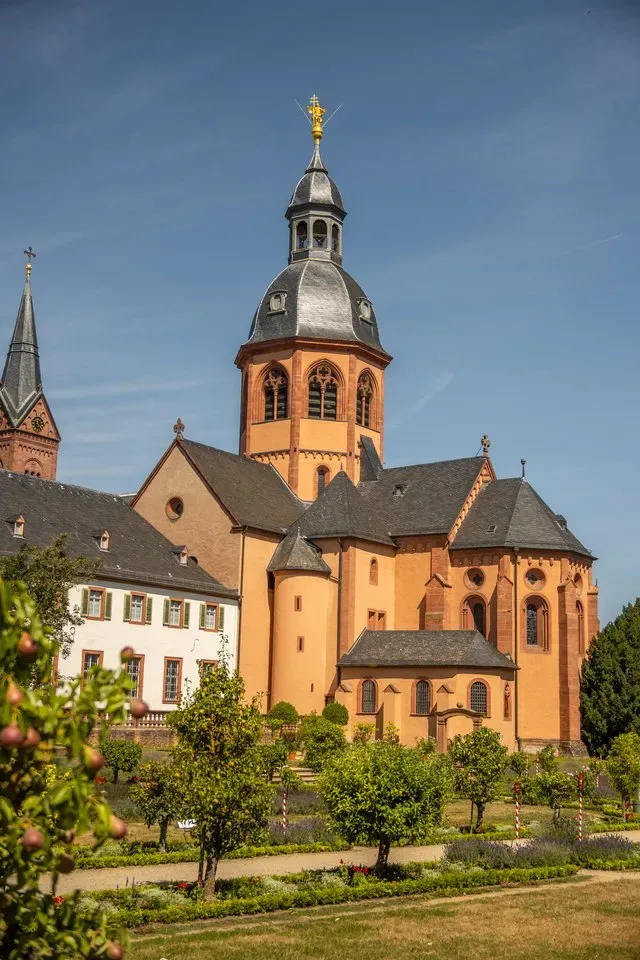
Seligenstadt is a beautiful town along the Main, with a surprisingly well-preserved Altstadt full of half-timbered houses, old monastery buildings and cosy squares. During our walk, we discovered, among other things:
- The Einhard Basilica – an impressive Romanesque church built on the remains of a Roman fort.
- The former abbey – with a beautiful baroque garden, ideal for unwinding.
- The Market Square – the beating heart of the town, with terraces, fountain and view of the basilica.
- The alleys around the Steinheimer Tor – full of half-timbered houses and small shops.
We could have easily stayed there for another day, but our next night’s stay was already fixed. Definitely a place I want to return to one day! The Saturday morning market was particularly memorable: the square full of locals sipping wine and some tapas as early as 11am. Lovely to see and something we would have loved to have participated in a bit longer.
👉 More tips on what to do in Seligenstadt? Read my full blog post here.
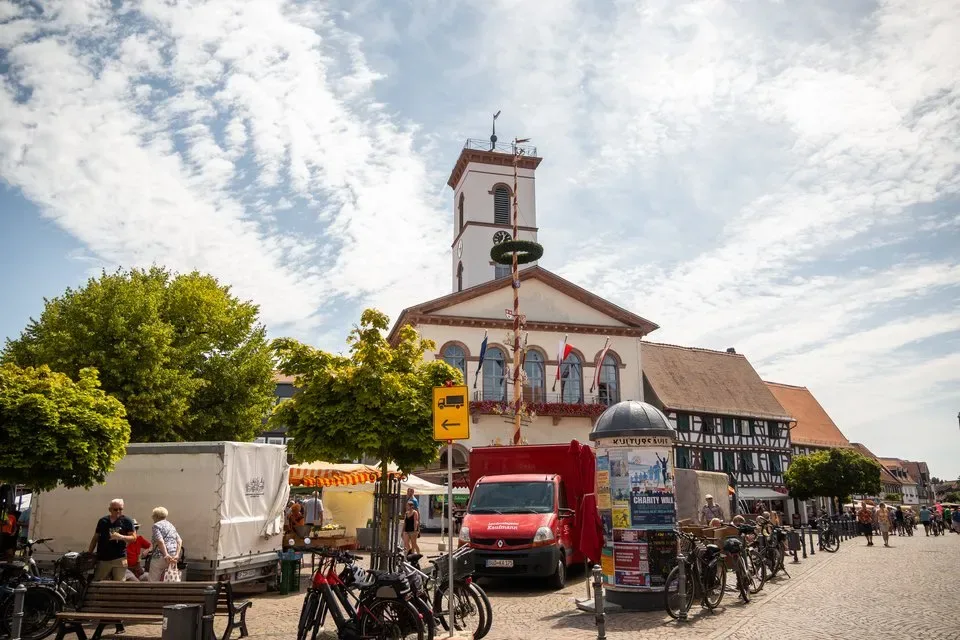
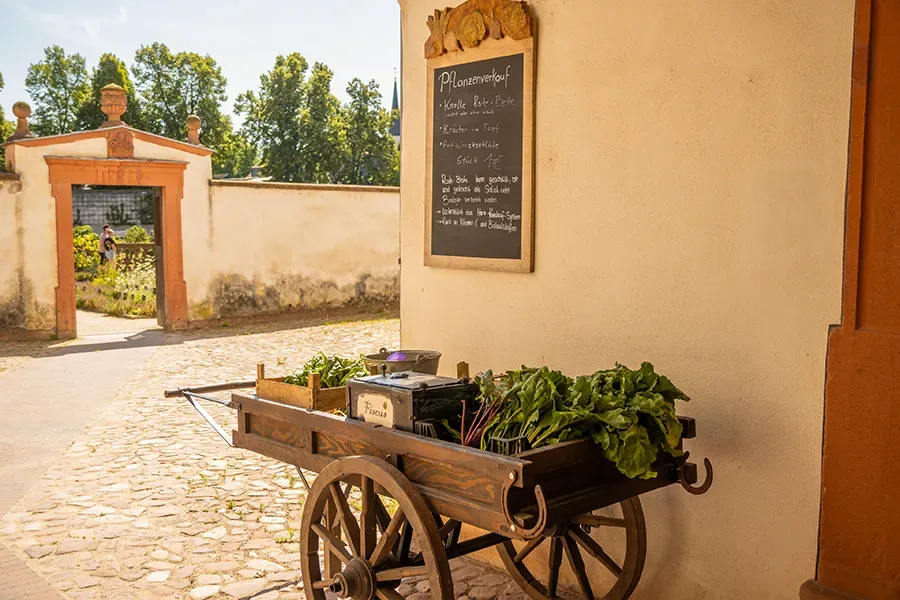
Stop 1: Hanau-Steinheim
We started the drive towards Grünberg with a stop in Hanau-Steinheim, an old district of Hanau across the Main. It is small and a tad forgotten, but you can still find original half-timbered houses and an old fortress wall.
At the central square, we stopped for lunch at Lug ins Land – a restaurant with beer garden in the centre of the village. Flammkuchen and a German beer… that’s all it needs sometimes. The town is otherwise not particularly well maintained, but for a short break it is perfect.
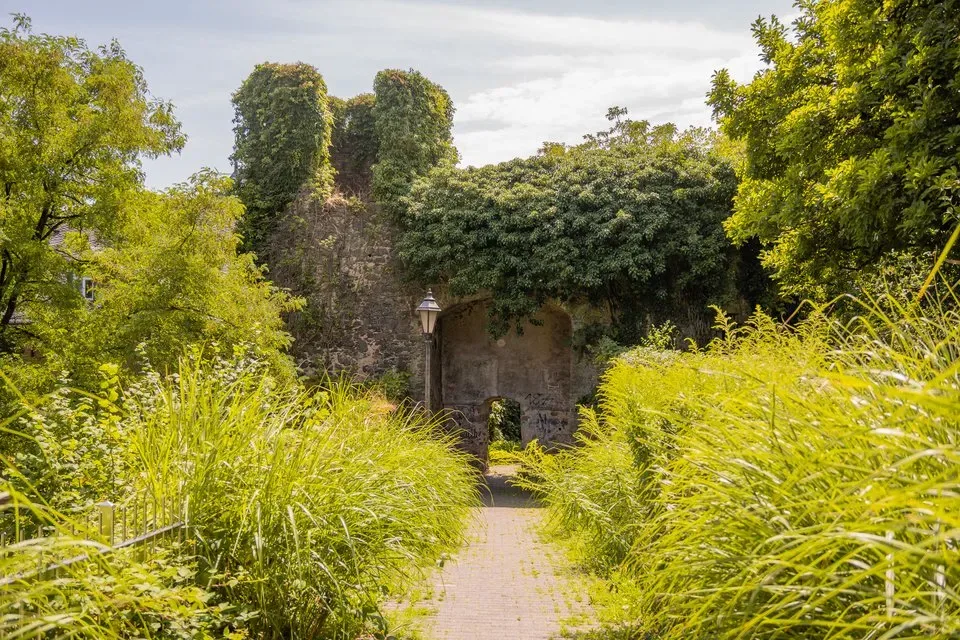
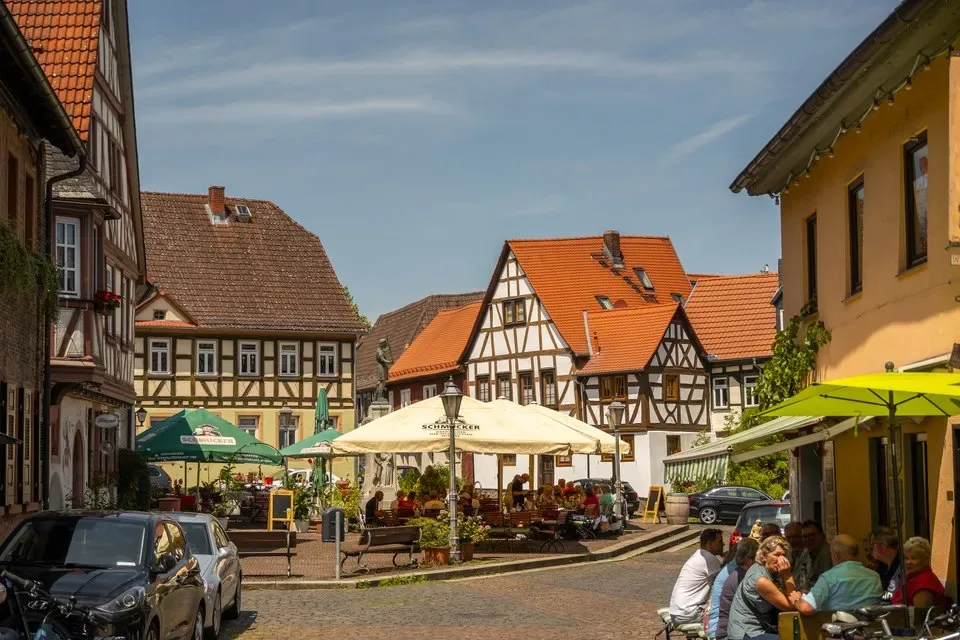
Stop 2: Steinau an der Straße
Our second stop was a hit: Steinau an der Straße is not only charming, it is also the former home of the Grimm brothers. Today, their house is a museum you can visit. You stroll along one long main street full of old half-timbered houses.
Be sure to visit Schloss Steinau, the village’s old castle, which you can also walk through freely. Inside, you’ll also find a museum you can visit.
For cake and tea, the Literaturcafé comes highly recommended: a quiet indoor garden and delicious homemade patisserie.
Then again, better leave your ice cream: the ice cream bar in the centre had bad reviews and… they unfortunately turned out to be justified, woops.
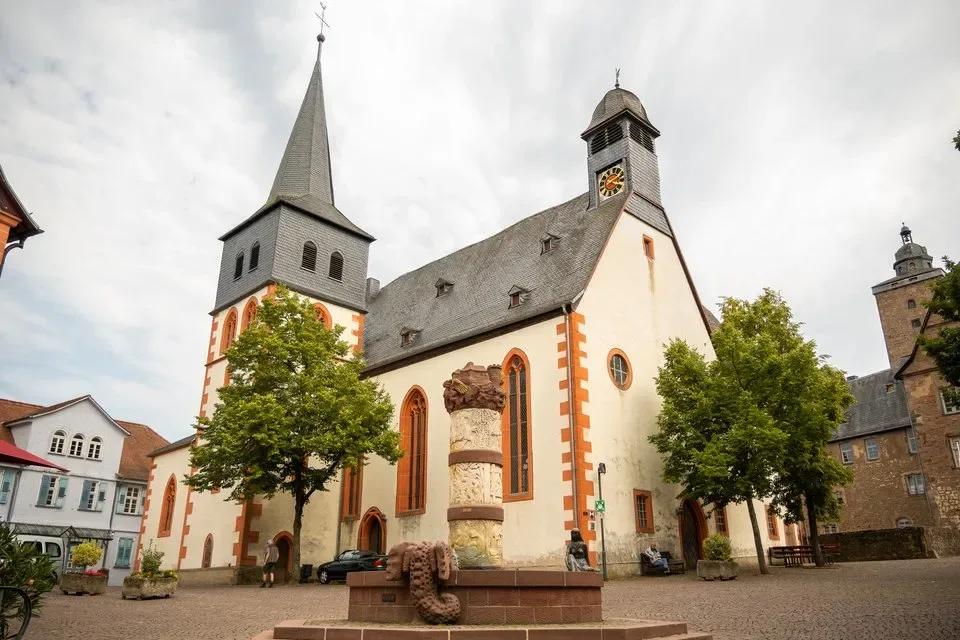
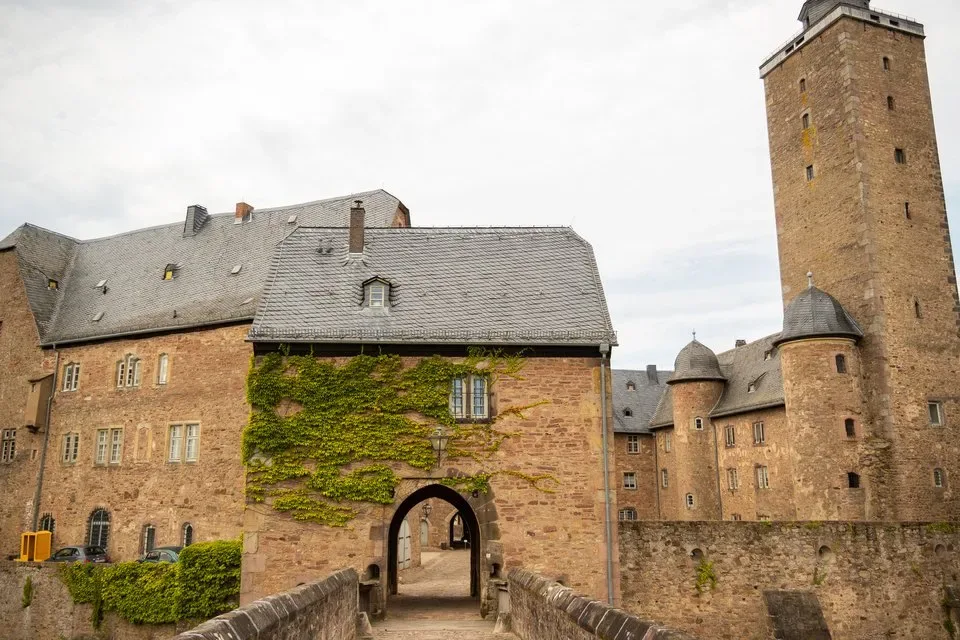
After a short walk and some new impressions, we drove on to our final destination of the day: Grünberg.
Grünberg originated in the 12th century and grew into an important trading centre thanks to its location along the old ‘Via Regia’ trade route. Today, you walk through a compact but atmospheric Altstadt full of half-timbered houses, fountains and cosy streets.
Unique to Grünberg are the natural springs in the valley below the town, which for centuries served as both water supply and energy source for the local mills. A quiet overnight spot with not too much tourist passage.
Tip: download the GPX route of our day here.
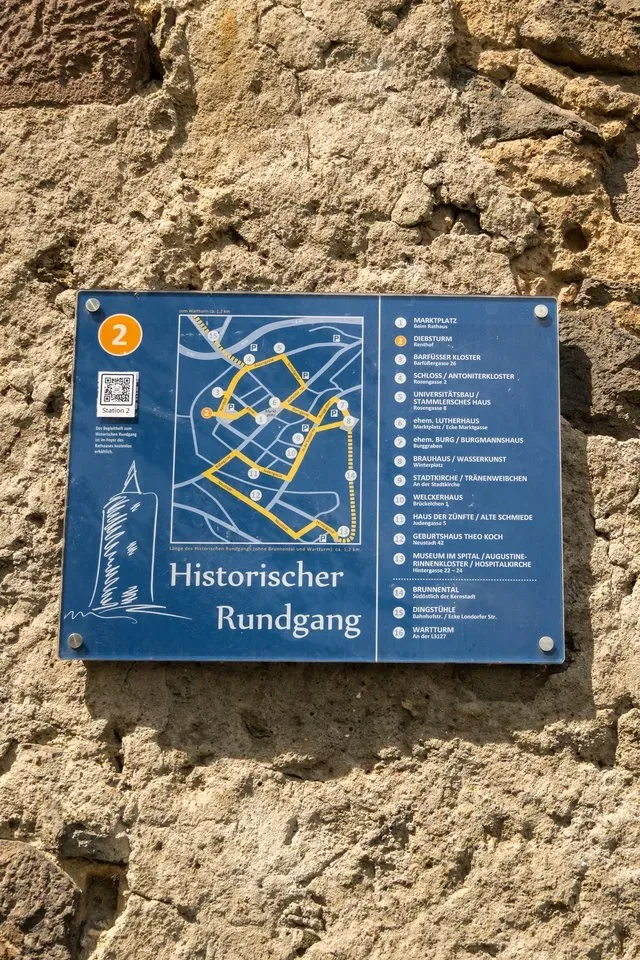
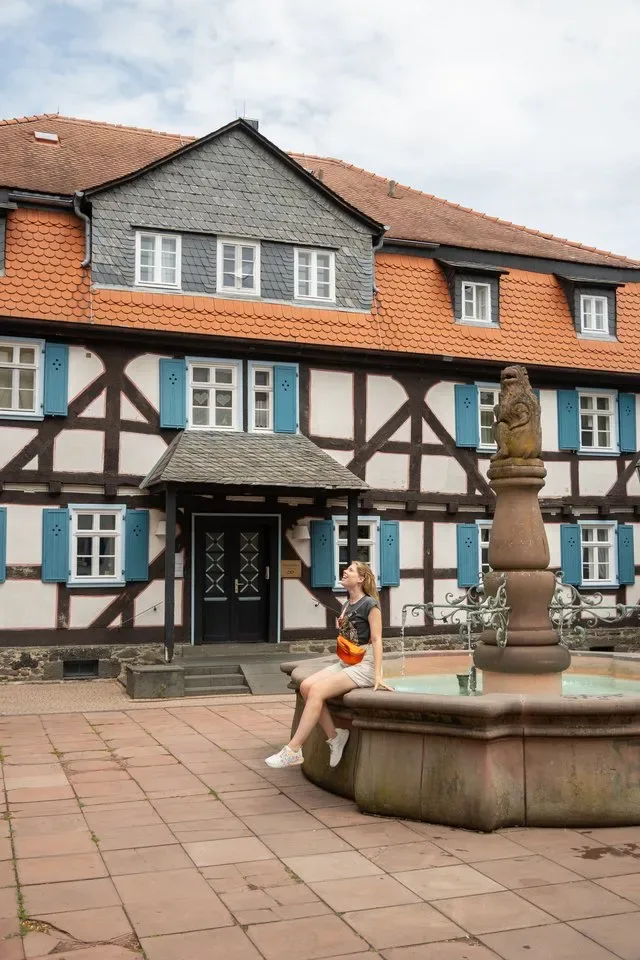
Overnight stay in Sporthotel Grünberg – above the valley
We stayed at the Sporthotel Grünberg, a large hotel above the town. It is not in the centre itself, but across the valley. The rooms are simple but comfortable, the view of the green surroundings is beautiful and the breakfast buffet was excellent. Don’t expect a charm hotel, do expect a practical base with everything you need.
From the hotel, we walked down through the valley towards the town. A tough descent (and climb on the way back!), but the route past the springs and greenery is really pretty.
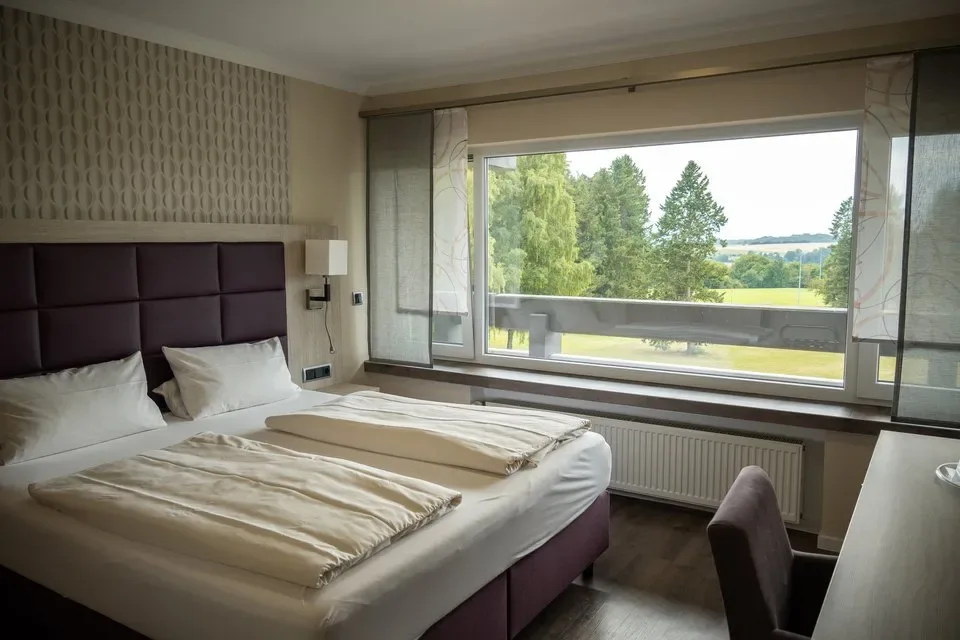
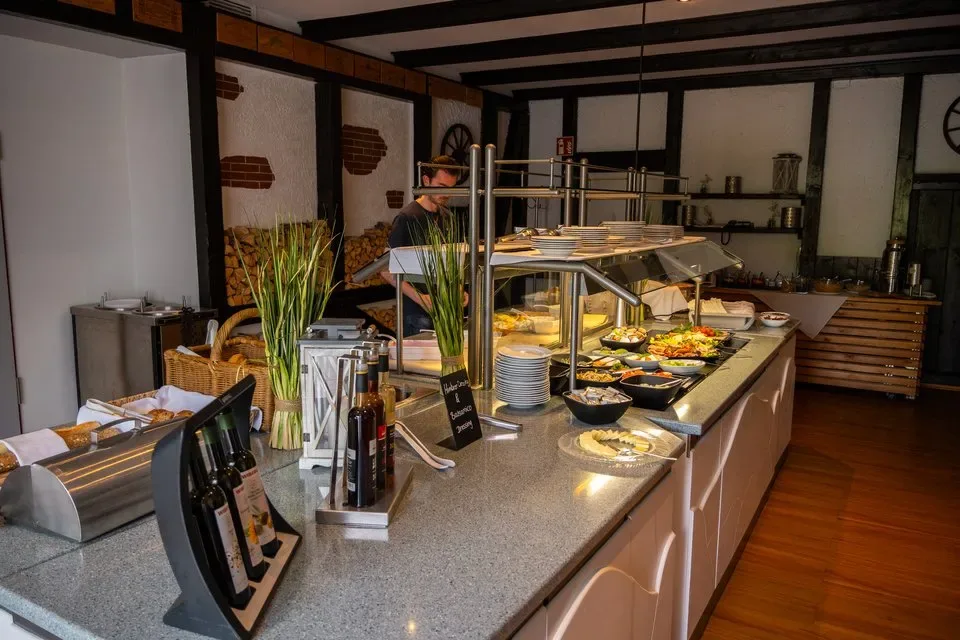
Eating like a local at Gaststätte Lippert’s
For dinner we ended up at Gaststätte Lippert’s, a traditional restaurant frequented mainly by locals. No bells and whistles, but honest German fare such as a rich variety of schnitzels. It felt a bit like my grandmother was at the cooker – and I mean that as a compliment. Not an Instagram-worthy setting, but super tasty and authentic.
Tip: Also taste the Licher beer, a locally brewed lager. You can’t get more German!
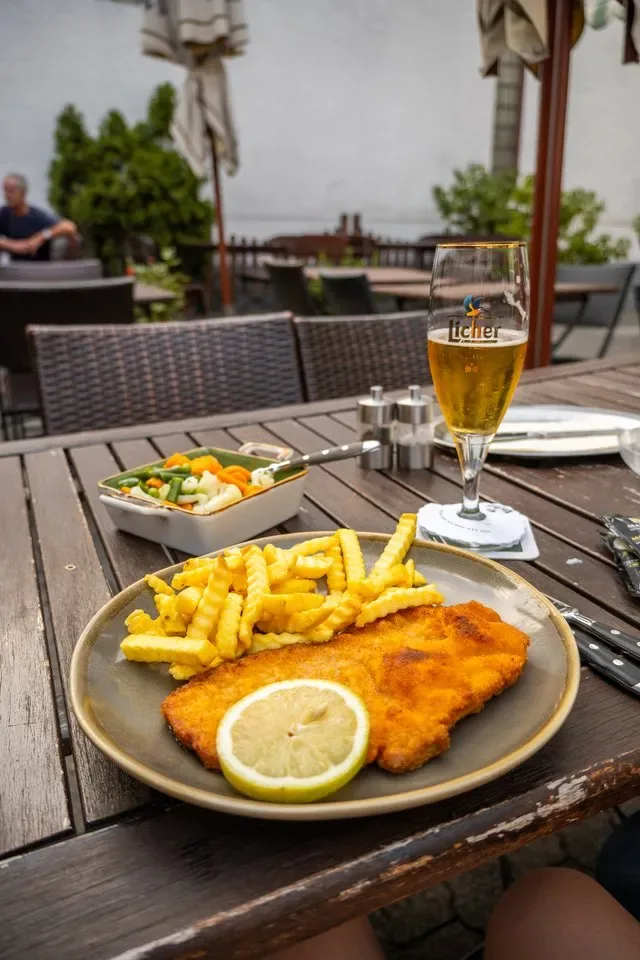
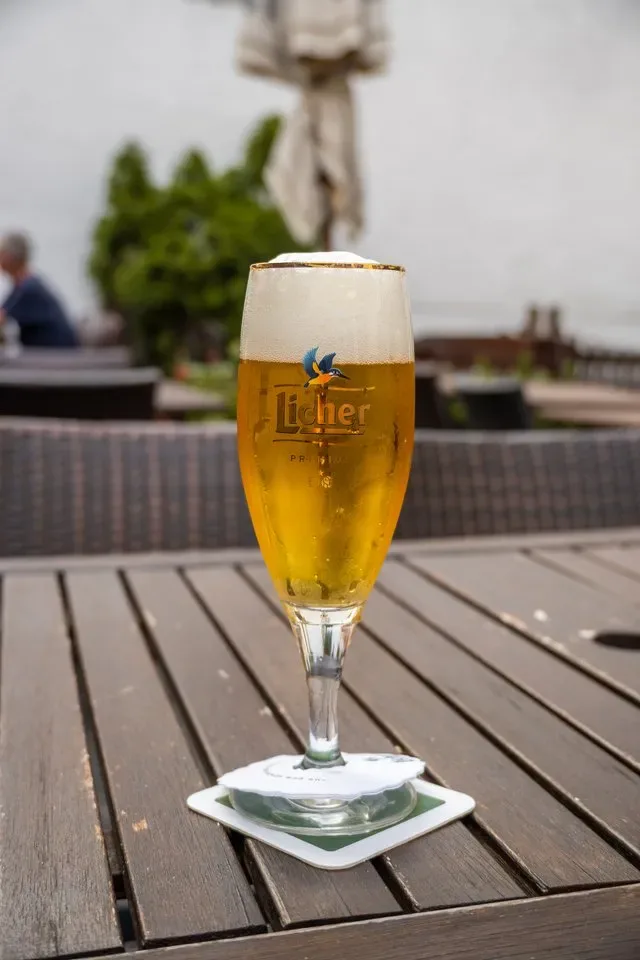
Day 4: from Grünberg to Braunfels
Thelast full day of our motorbike tour Germany began again with a town tour, as we had seen very little of Grünberg the night before. Fortunately, we were given a fascinating tour by a local who knew all about the town’s history – from the spring valley to the half-timbered houses, old town gates and ancient wells.
Grünberg is not a big town, but it is a place with a surprising amount of history. Some things you should definitely see:
- A walk through the valley of natural springs – this green valley was the town’s lifeline for centuries and today is an idyllic place to stroll.
- The historic well in the middle of the market square – an important symbol of the town.
- The charming half-timbered centre – including the old town hall, stone fountains, and photogenic streets such as Rabegasse.
- The old town tower – you can go and ask for the key and take a look up there.
- And if you look closely: the interactive XL marble track in the valley, which is fun to test out for a while
👉 Looking for more inspiration? Read my blog post about what to do in Grünberg here.
After the tour, we left for Braunfels, with one major stop along the way: Wetzlar.
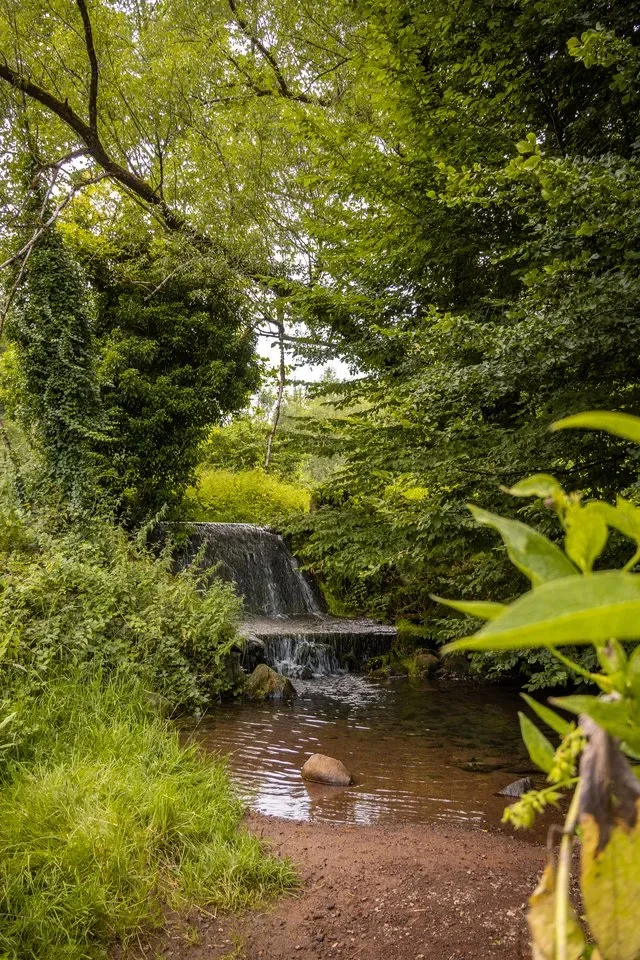
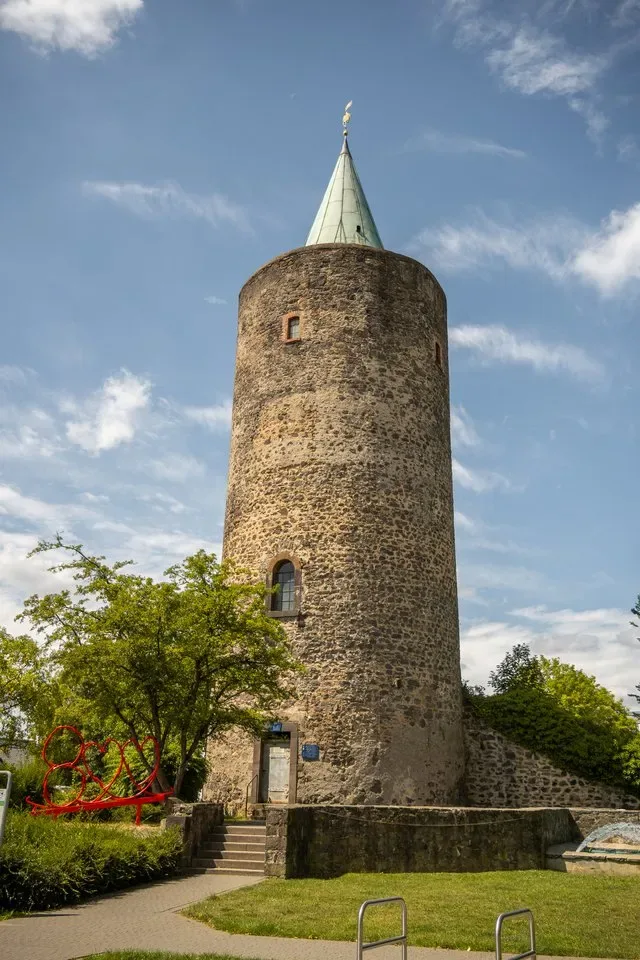
Stop: Wetzlar
Wetzlar is not a village like most previous stops, but really a small town with a historic Altstadt, lots of shops and cosy places to linger for a while. The town lies along the Lahn and is built on a hill, so prepare for some climbing. Fortunately, you will be rewarded with beautiful views, cobbled streets and lots of half-timbered architecture.
What you should definitely not miss:
- The imposing Wetzlar Dom, a Gothic cathedral with a remarkably unfinished tower.
- The Altstadt, with colourful facades, narrow alleyways and small shops.
- The Alte Lahnbrücke, an old stone bridge over the Lahn with beautiful views of the city.
- The river promenade, where you will find cosy summer bars and terraces along the waterfront.
We had lunch at Café Dolce, a fine spot with homemade cakes, toast and bagels – ideal for a light lunch with a view of the church. Tip: Sundays are quieter here and some things are closed, but it’s still a fine stop during your motorbike tour.
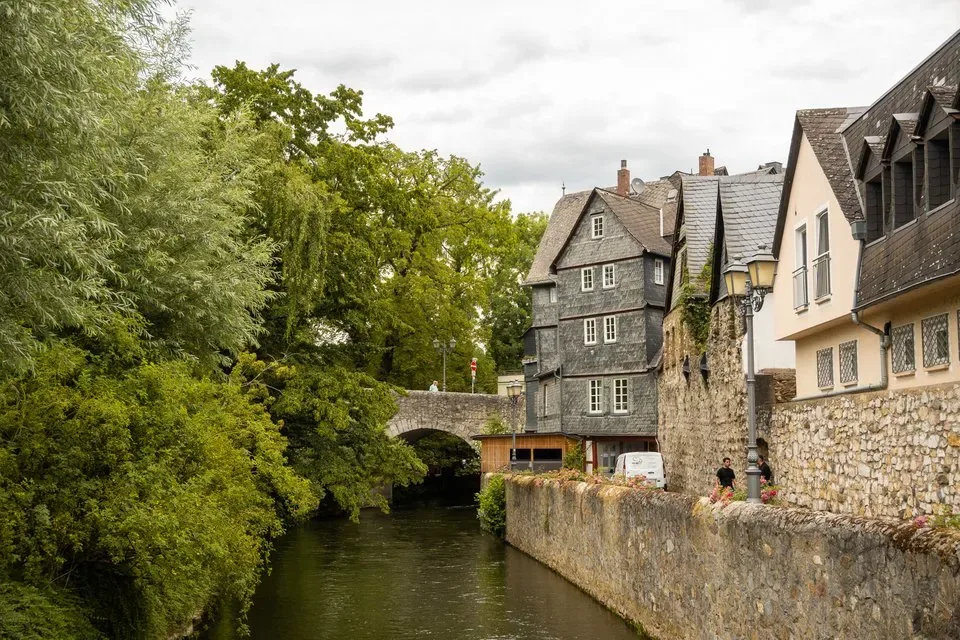
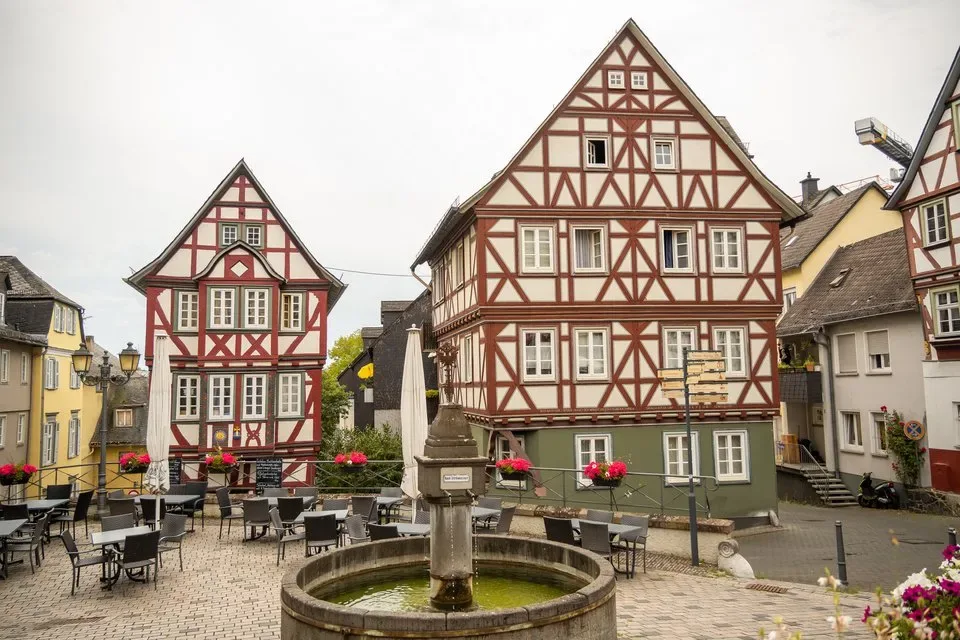
Arriving in Braunfels – fairytale on a hill
As we approached Braunfels, we could already see it in the distance: a gigantic castle on top of a hill, surrounded by forests. Secretly, I hoped this would be our stop for the evening and yes, it was our final destination for the day! Braunfels took me completely by surprise – I honestly didn’t expect much from it, but it was perhaps the most beautiful stop of all our motorbike tour Germany.
Located in the Lahn valley, Braunfels is best known for its castle, which towers over the village like a postcard. The town was already mentioned in the 13th century and around the castle grew into an important residence of the Counts of Solms-Braunfels. Today it is a peaceful place with a beautiful historical market square, cosy streets and – yes – that impressive castle that is still privately owned.
Tip: download the GPX route of our day here.
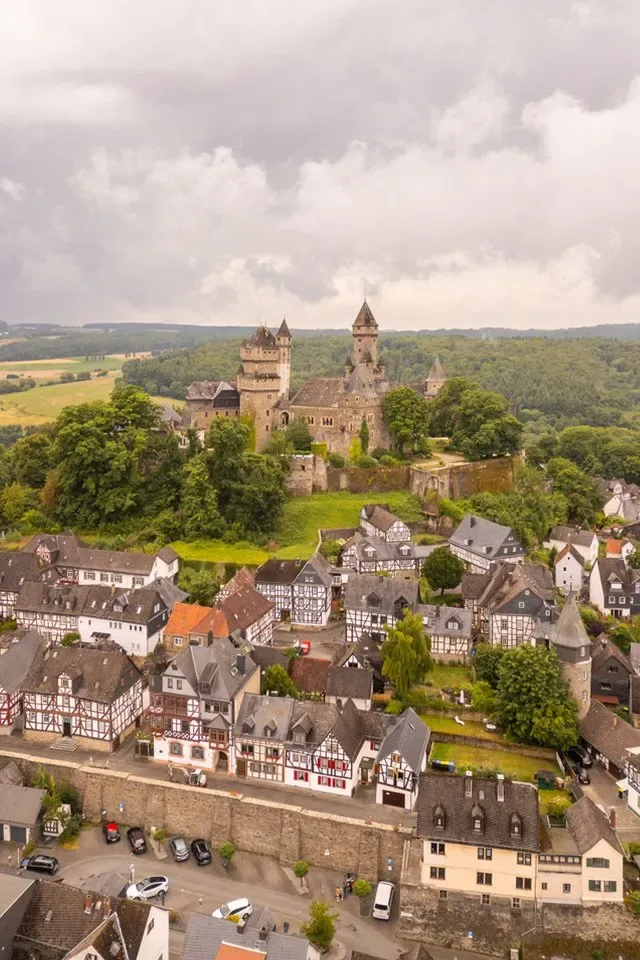
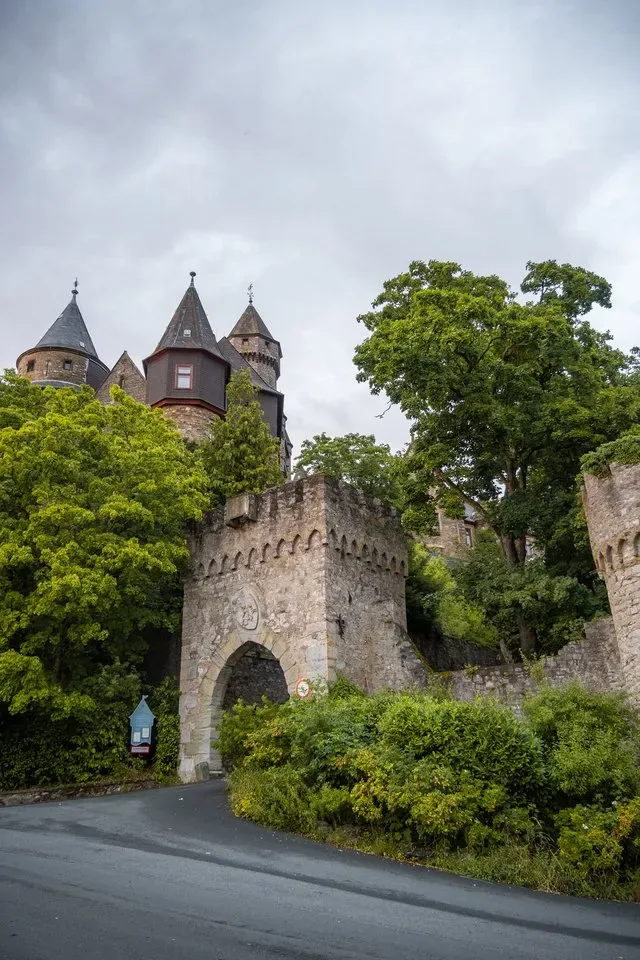
Staying and dining at Hotel Restaurant Solmser Hof
We stayed on the market square, in a traditional German hotel that immediately catapulted me back fifty years in time: Zum Solmser Hof. Or so it seemed anyway, because I’m not that old yet to be able to attest to that. Everything was still authentic in the room, but also in the cosy stube as breakfast room and restaurant.
Looking down from the window of my room onto the square, I felt exactly like a princess from a Disney fairy tale. In the evening, we ate on the hotel terrace, surprisingly with Greek specialities and not German ones, which were really top-notch by the way!
We took a short evening stroll through Braunfels Castle that evening. You can’t visit it fully without a guided tour, but you can walk through the entrance gate and take a peek between the towers and thick walls. Especially at sunset, this is magical.
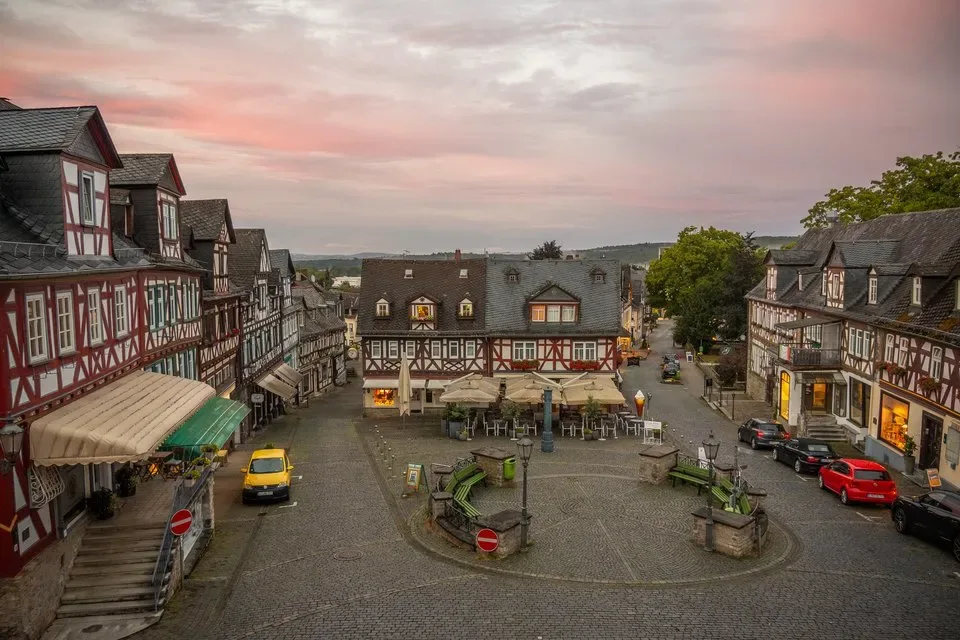
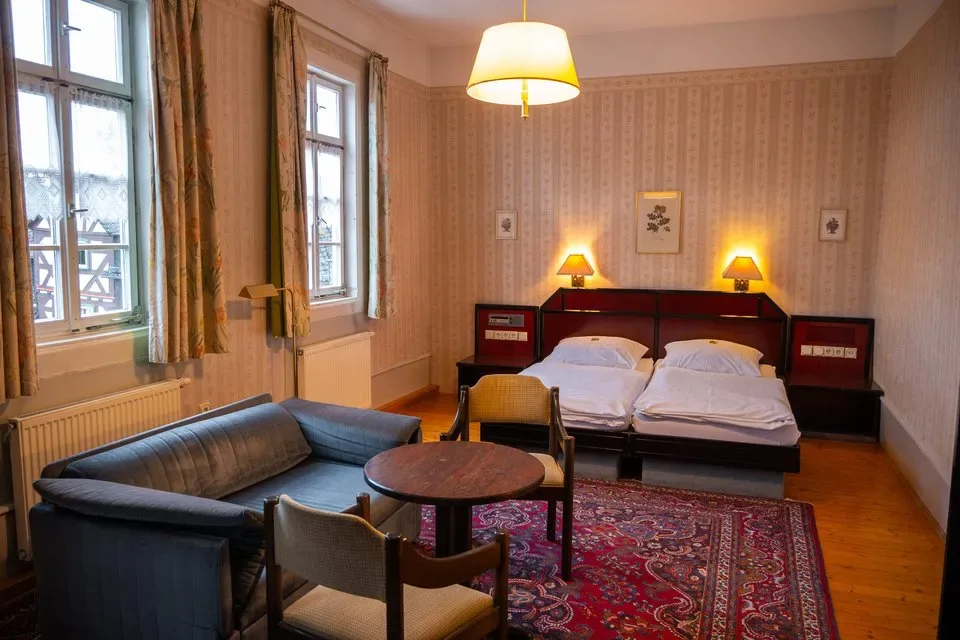
Day 5: Back to Limburg an der Lahn
Our last day started with a hearty dose of charm, because before driving back to Limburg an der Lahn, we wanted to explore Braunfels. The night before we had already caught a glimpse of the town, but now we took our time to stroll around at leisure. And it was definitely worth it.
What you should definitely see in Braunfels:
- Braunfels Castle – an imposing fairytale castle still inhabited by the noble Solms-Braunfels family. You can partially visit it or just walk through the impressive gate and admire the courtyard.
- The Market Square – surrounded by colourful half-timbered houses and overlooking the castle; one of the most photogenic spots of the whole trip. Get a brochure with all the info about the buildings from the tourist office.
- Numerous hiking trails in and around Braunfels, from a short route around the town to long-distance routes to the surrounding towns.
👉 For all tips and photos: Read my full blog about Braunfels here.
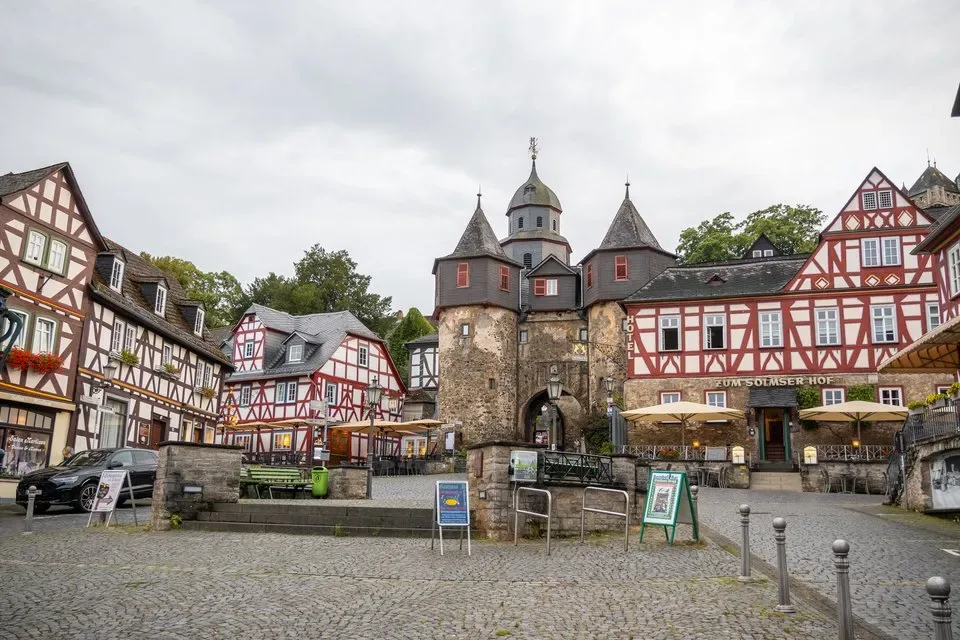
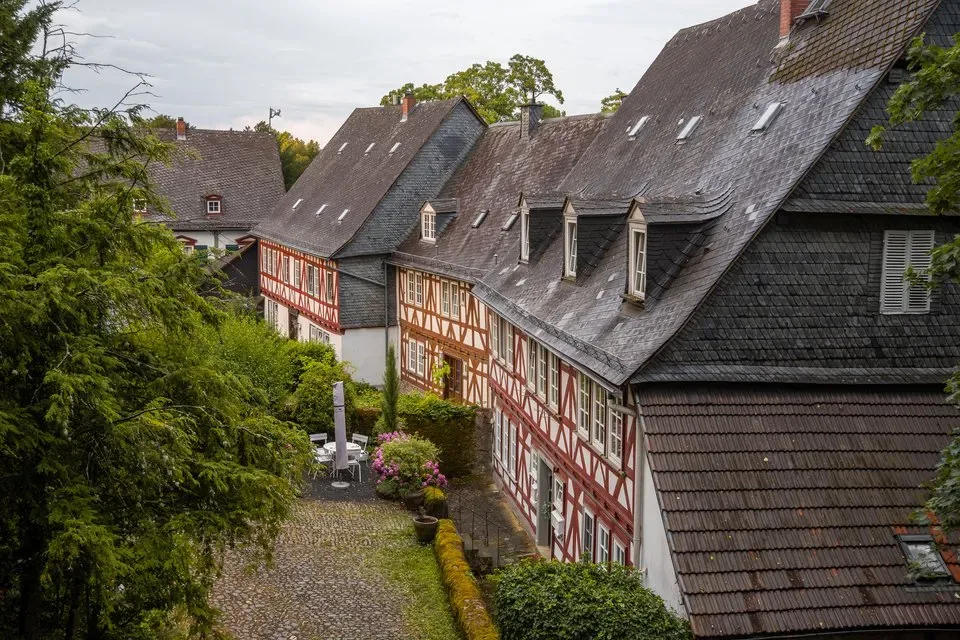
Drive back to Limburg – in between the rain
After our visit to Braunfels, it was time to return to where it all started: Limburg an der Lahn, where our car and remorque were still neatly parked. Unfortunately, the weather was a bit disappointing that morning – we got some heavy rain showers – but luckily we were able to drive between the gusts and still pack dry.
The route between Braunfels and Limburg was not too long (just under an hour), and with its rolling landscapes and expansive views, it was a nice end to the trip.
Tip: download the GPX route of our day here.
Back to Belgium then! And survived our first motorbike trip through Germany without any accidents. I found it a fantastic experience, especially because you pass so many half-timbered villages, and would do it again in a heartbeat. But then another region of course, because via the website of the Deutsche Fachwerkstraße you can find lots of other routes.
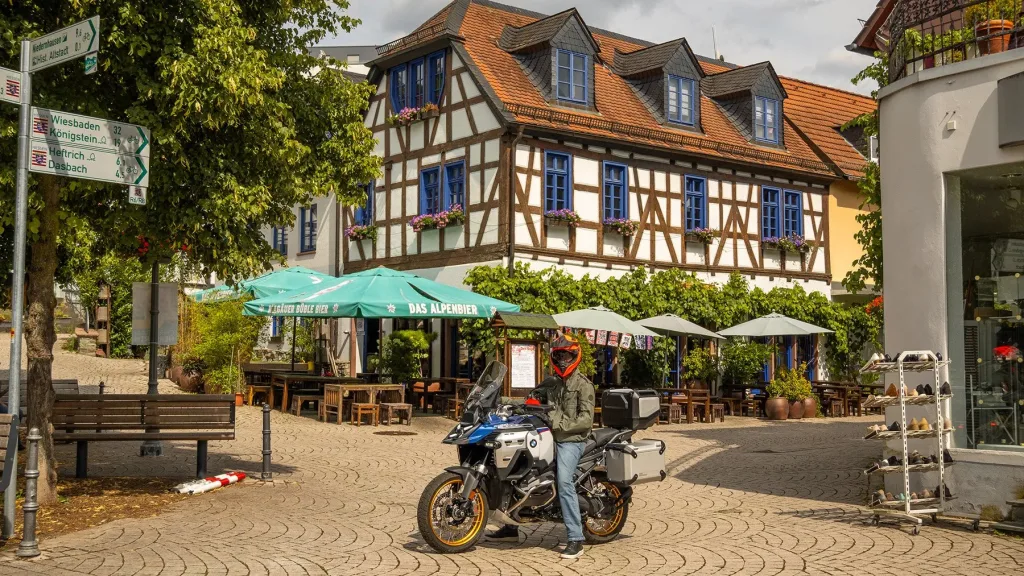
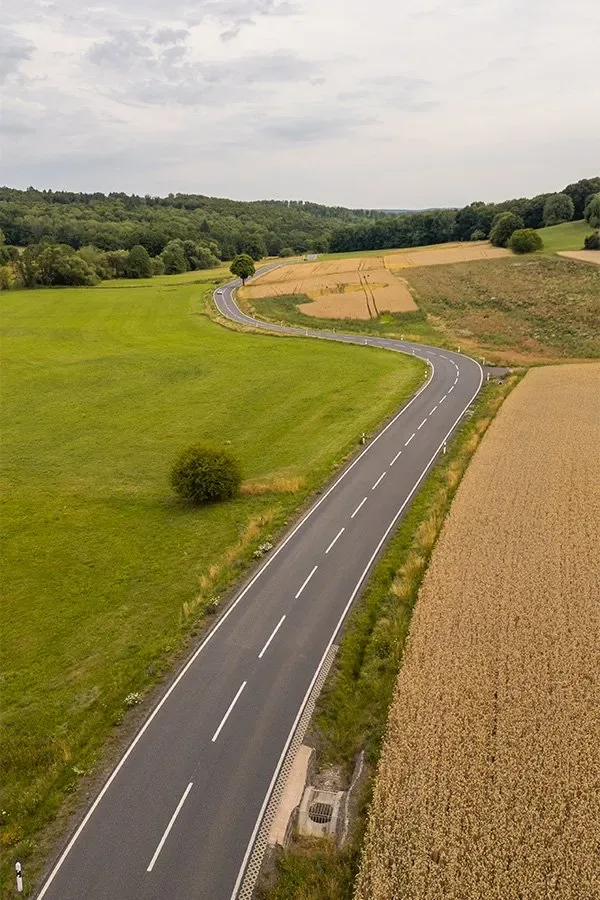
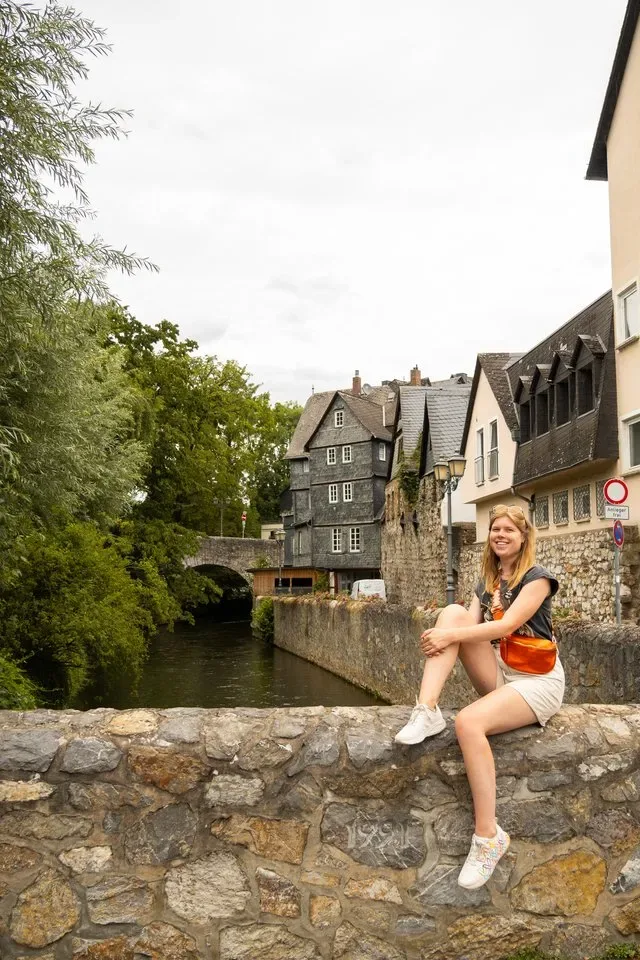
Have you ever been on a motorbike tour in Germany, especially through the Frankfurt and Hesse region? If so, be sure to leave them in the comments below. (I could use some motorbike tips myself 😉)

